
This article deals with the history of fingering systems for musical instruments and with the notation used to indicate them to the player. Unless otherwise stated the numbering of the digits of each hand follows modern practice: for keyboard instruments, 1 = thumb, 2 = index finger, 3 = middle finger, 4 = annular, 5 = little finger; for bowed string instruments, 0 = open (i.e. unstopped) string, 1 = index finger, 2 = middle finger, 3 = annular, 4 = little finger. Fingering is not normally shown in music for wind instruments, while music for plucked string instruments (lute, vihuela, guitar, harp etc.) employs fingering techniques that are either embodied in the notation or outside the scope of this article.
MARK LINDLEY (I, 1 and bibliography), GLYN JENKINS/MARK LINDLEY (I, 2), SONYA MONOSOFF/ALISON CRUM (II, 1), PETER WALLS (II, 2(i)), SONYA MONOSOFF/PETER WALLS (II, 2(ii)), SUZANNE WIJSMAN (II, 3), RODNEY SLATFORD (II, 4 and bibliography), MARC ECOCHARD, BRUCE HAYNES (III, 1), ARNOLD MYERS (III, 2 and bibliography)
Fingering, §I: Keyboard fingering.
The oldest known fingering rules for fast notes, summarized in ex.1, are from a manuscript of Hans Buchner’s Fundament Buch, dated 1551 (some 13 years after his death). It would appear from these examples that he reserved 3 for weak notes. However, the manuscript also gives the fingering for an entire piece, and here 3 takes all the notes which have a mordent, and various minims weak or strong, but is generally reserved for weak crotchets, quavers and semiquavers. In exx.2 and 3, the actual duration of the first bass note (which completes a phrase) has to match the crotchet or quaver in the middle voice. If various other minims are not also to be truncated drastically, the hand must perform some rather novel gymnastics (fig.1). Probably the semiquavers in ex.4 would be played with the back of the fingers facing left and the tips touching the keys as shown in fig.2. Only a player quite at home with manoeuvres of this kind can hope to distinguish between interesting fingerings and the mistake in ex.2, where the c was overlooked and the c' fingered accordingly. The proper emendation is to play the octave with 5 and 1, like all the other octaves; but b is still played with 3, as in the next bar.


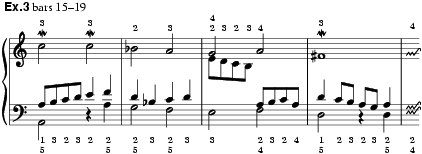

A ricercar by Christian Erbach is preserved with fingerings in a Bavarian manuscript of the 1620s. Once again, 3 has mostly weak quavers and semiquavers (ex.5), and here also one finds certain fingerings which even a fairly thorough German tutor might not explain (as in ex.6, where the 4 on d' entails a cadential rubato and a relatively deliberate articulation). A very high wrist can facilitate some of the fingerings, such as 5/4 for certain harmonic 3rds in the right hand (ex.7) and even for some harmonic 4ths.

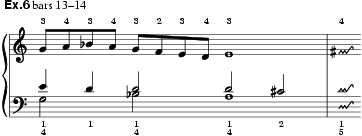

In Elias Ammerbach’s two sets of fingered exercises (1571, 1583), 3 is used on weak or strong notes indifferently (exx.8–9), and the left thumb is applied to the last note of certain groups (ex.9–10) even if it may be a chromatic note. (The right thumb is not explicitly called for in any German Renaissance source.) Ammerbach fingered most groups independently of each other, and often the same finger has the last note of one group and the first of the next. Perhaps the weak note should be played with merely a finger motion but the following strong note with a hand motion as well. Ammerbach may well have used a moderately low wrist as infig.3.



In these exercises and in Erbach’s ricercar, to slur all those notes which can most readily be slurred would often make a very silly, ‘hiccuping’ effect (ex.11), so the phrasing is best achieved by shadings of articulation and tempo in a patina of marginal detachments. This is probably what the early tutors meant by terms like ‘legato’ and ‘smooth’.

Our only 16th-century Italian source of information, part i (1593) of Girolamo Diruta’s Il transilvano, prescribes that the wrist be ‘a bit high’ (‘alquanto alto’) to keep the hand and arm level. Diruta dwelt upon the importance of a quiet hand, relaxed as if caressing a child, except that in dances one might instead strike the keys, ‘harpsichord-style’. He said the arm should guide the hand, and the fingers should be ‘alquanto inarcate’, which has been rendered by various translators as ‘slightly’, ‘somewhat’ or ‘rather’ curved.
Diruta was the disciple of a renowned virtuoso, Claudio Merulo, yet it is hard to extract a clear picture of contemporary practice from his book. He finds that in right-hand passages moving away from the body, 2 (with no notes to play) tends to become straight and still (‘sforzato’), that the thumb also grows stiff under the hand, and that 5 rather draws in. He reports that many organists had accustomed the hand to these defects, to the detriment of their playing, but he does not say whether they were well-known performers or nonentities. He reserves 3 for ‘bad notes’ (‘note cattive’), but all the later Italian writers, including Banchieri in 1608, give the strong notes to 3 or are indifferent to the matter. Diruta reports that for scales the left hand should descend (2)3232 … even though ‘many eminent men’ preferred to descend with 4, and that either hand should move towards the body (4)3232 … even though many eminent men preferred to ascend with 1 and 2 in the left hand. He says bad notes which leap should be played with 3, adding that they can be played with 1 or 5 if the leap is larger than a fifth; but as none of his examples is fingered it is not clear whether a bad note before a large leap should ever be played with 3, nor whether a bad note after a leap might ever be played with 1 or 5.
According to Diruta, diminutions must be played ‘cleanly, that is, not pressing a key down before the finger is lifted from the previous one, moving up and down at the same time’; however, his examples of diminutions include 7ths for which 2–5 would be the smoothest fingering not unmistakably contrary to his rules.
One reason why modern players have trouble with these fingerings is that in bringing the right hand to the keyboard they habitually lead with the thumb rather than with the index finger. The early fingerings oblige the player to orientate the right hand with some finger other than the thumb. Ex.12 may show that this way of approaching the keyboard remained in currency during the 17th and early 18th centuries, as did the use, in appropriate circumstances, of the same finger for two successive notes in a tune (ex.13 and 38–9). Where one hand had to take two parts this was a very familiar technique throughout the 16th, 17th and 18th centuries (ex.14). Some tutors implied that each kind of harmonic interval or chord was always to be played with the same fingers no matter what the context. Such rules may have been over-simplified, but this aspect of the technique was at any rate simpler than a Romantic organist could conceive.
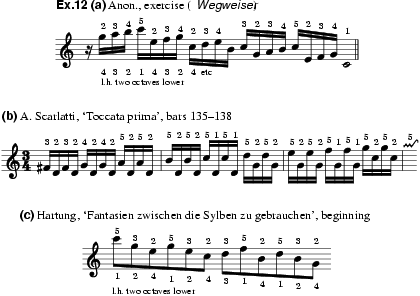
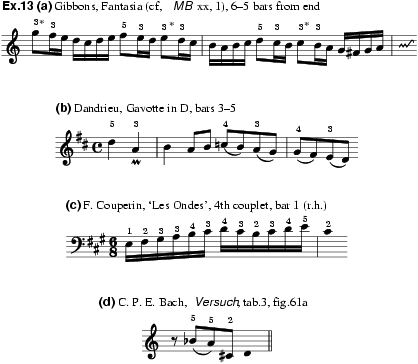
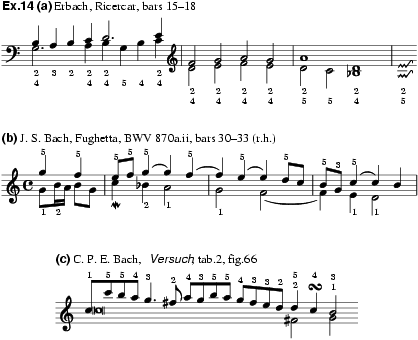
We have no 16th-century Spanish music with fingerings, but the rules given in four treatises and prefaces (Bermudo, 1555; Venegas de Henestrosa, 1557; Santa María, 1565; H. de Cabezon, 1578) show that scales were taken with various fingerings. Bermudo prescribed 4321 4321 and 1234 1234. Cabezon, in his edition of the music by his blind brother Antonio, recommends to beginners: right hand up 343434, and down 323232; left hand up 4321 4321, but down 1234 3434. A preference for paired fingering away from the body is evident also in Venegas de Henestrosa’s advice (again for beginners) that the left hand go up 4321 321, but down 1234 3434, and the right hand go down 4321 3 … (or perhaps it might start with 5), but up 3434 (once 4 has been reached after starting from 1 or perhaps 2 or 3). Santa María’s suggestions were the most elaborate; but for all fingerings alike he said that the hand should point towards the keys to be played next and the finger which has just played should be lifted before the next one plays. So if the thumb followed 4 in a scale away from the body, the hand was turned outwards and the thumb would approach its key as 4 was just releasing its hold.
The English may have been the first to use 5 at the end of right-hand runs (ex.15). This was corollary to taking strong notes with 3 – a persistent habit (ex.16) which was, however, occasionally resisted to avoid a shift within a three-note span (ex.17). The left thumb was most often used instead of 3 in ascending scales (ex.18). Repeated notes would normally be taken with changing fingers (ex.19). (In the 18th century they were still usually played in this way, as in ex.20, and only sometimes with the same finger as in ex.21).
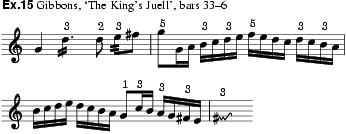

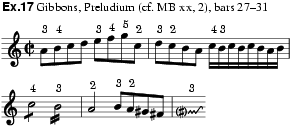




A number of mid- to late 17th-century English manuscripts contain fingered music, but to assign a date to these fingerings would be so problematical that no-one has distinguished much between ‘early’ and ‘late’ techniques among the virginalists.
In north Germanic fingerings of the first half of the 17th century, 3 tends to take weak notes in the left hand but strong in the right (ex.22), with occasional exceptions for three-note spans (ex.23) or various other contingencies (as in ex.24). In view of this, and of the contrary earlier traditions for the role of 3 in paired fingerings, we might expect to find many later examples of indifference, and we do (ex.25).

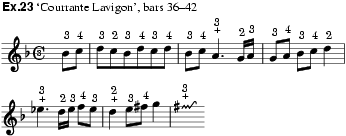
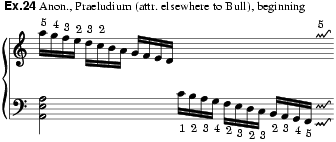

During the first half of the 18th century the main trend was to add new technical devices without rejecting the old ones, so the fingerings were rather unsystematic and dependent upon the immediate musical context. Given a suitable occasion, 4, 3 or even 2 might cross beyond 5 (ex.26); 5 might cross over 1 (ex.27) or under 3 (ex.28); 2 and 4 might cross past each other (exx.29 and 31); the thumb might take a chromatic note (ex.30) or might not (ex.31), and scales might be rendered by an elaborate choreography of both hands (ex.32). It was in this context of nimble permutations that the old Spanish unpaired scale fingerings apparently began to be taken up outside Iberia in the 1720s: in Rameau’s Traité de l’harmonie (1722, for slow bass notes as in ex.33), in a contemporary manuscript of Handel’s G major Ciacona (ex.34), in Della Ciaia’s Sonate, op.4 (?1727), and no doubt elsewhere. Various tutors from 1730 onwards prescribed them (ex.35), and Hartung in 1749 referred to 3434 and 3232 as ‘that impoverished fingering’.
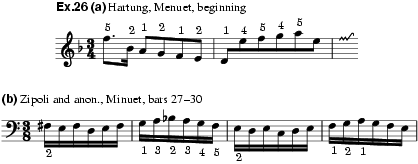



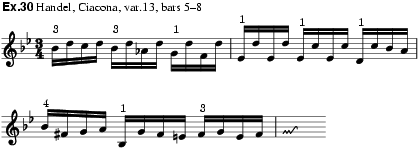

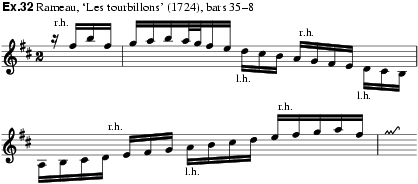


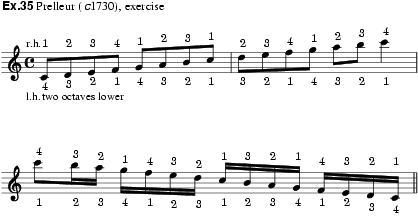
The effect of these developments upon articulation is not entirely clear. In 1735 Mattheson stated that a teacher should tell his pupil ‘never to apply the next finger until he has lifted the previous one’. Marpurg in 1755 said that while slurring and staccato were usually indicated by signs in the music, the ordinary procedure, namely to lift the finger from the preceding key very quickly just before touching the following note, was never indicated because it was always presupposed. Dom Bédos in 1778 dwelt upon the necessity of little silences at the end of each note on any keyboard instrument, without which the music would be like an inarticulate series of vowels without consonants. Czerny in praising Beethoven’s legato referred to Mozart’s ‘chopped-up and clipped-off playing’. On the other hand, Duphly told Lord Fitzwilliam, some time after 1754, that in le jeu françois ‘one must not quit one key until after having taken another’. How then should one interpret Forkel’s statement (1802) that J.S. Bach – whom he never heard play – had found a ‘middle path’ between too much legato and too much staccato, and so achieved ‘the highest degree of clarity (‘Deutlichkeit’) in the playing of single notes as in the pronunciation of single words’?
Some earlier French sources are of interest in this regard. In 1665 Nivers, discussing distinction and coulement, said it was very appealing to ‘mark all the notes distinctly, and to slur (‘couler’) some of them’ as a singer would do. For instance, in a diminution or roulade of consecutive notes, one should raise the fingers ‘soon and not very high’, whereas for ports de voix and the like as in ex.36, one should still distinguish the notes but ‘not raise the fingers so promptly: this manner is between distinction and confusion’. His illustrations of descending scales are shown in ex.25; for ascending scales he prescribed: right hand (1)23 4343 4; left hand (4)32 12121.
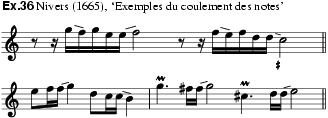
In a rubric to his ‘Démonstration des cadences’ (1688) Raison said that the port de voix should be executed with an overlapping legato; Saint-Lambert concurred in 1702, and Rameau in 1724 (ex.37). Some of the ornaments in Raison’s table are fingered (ex.38), and with this guide one can tell how nearly every note in certain ornament-laden passages in his music was to be taken (ex.39). This French playing was as distinctive as the melodic style which it served.
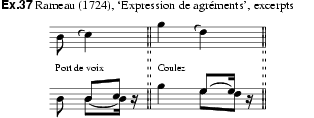
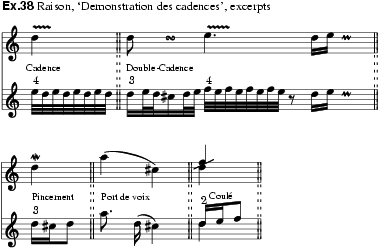
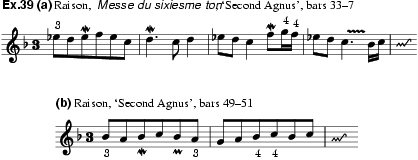
Saint-Lambert (1702, 1707) said the fingers should be curved to reach no further than the thumb, and advocated as quiet a hand as possible; his exact meaning can be seen by comparing ex.40 with ex.41. He proposed that to slur an arpeggiation be taken to mean that each note be held through to the end as in ex.42, and Dandrieu adopted this proposal in 1713 (as in ex.43). Saint-Lambert also suggested that for a run of quick notes towards the body, the customary right-hand fingering, 3232, which he himself had prescribed, was less convenient than the use, by the right hand, of corresponding left-hand fingering, 2121; this idea seems to have been ignored.


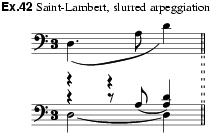

In his influential L’art de toucher le clavecin (1716) François Couperin said that the old-fashioned use of for successive 3rds could not render them legato (‘n’auoit nulle liaison’); his playing of 3rds is illustrated in ex.44. Sometimes Couperin used finger-substitutions (ex.45) – ‘too often and without need’ according to C.P.E. Bach (1753). Couperin’s scale fingerings (ex.46) imply an anacrusis leading into each beat, like the other exercises in the same set (ex.47), but he often phrased within the beat as in ex.31 (or also ex.13b). His attitude to technical drills was equivocal; he had his pupils practise not only the agréments but also brief, progressive ‘évolutions des doigts’ (ex.47), and one of his pupils even learnt to trill in parallel 3rds with one hand, but Couperin would not give himself ‘la torture’ to master such trills to his own satisfaction.

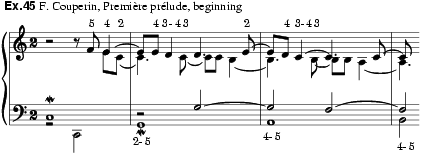


Rameau in 1724 said that ‘the raising of one finger and the touching of another should be executed at the same moment’. He prescribed that ex.48 be played over and over ‘with equality of movement’, thus anticipating the 19th-century conception of the five-finger exercise as a thing of beauty.

According to Forkel, the preliminary exercises which J.S. Bach gave to his pupils were cut from exactly the same musical cloth as the two-part inventions and the little preludes in Friedemann’s notebook. Bach’s pupils also had to practise, early on, all the ornaments in both hands – but apparently not scales, a considerable point of difference between his teaching and that of his son, Emanuel. Nor did Emanuel say of his father’s technique, as the standard English translation of the Versuch would have it, ‘I shall expound it here’; but rather, ‘I take it here as a basis’ (‘so lege ich solche hier zum Grunde’). Whatever the exact relation, the chapter on fingering merits a closer reading than the many infidelities of the translation allow.
Emanuel
said that the thumb, which his father had promoted to the rank of ‘principal
finger’, keeps the other fingers flexible because they must bend every time it
presses in next to one or another of them. He said the fingers should generally
be curved anyway (without saying how much), and the forearm should be a little
lower than the keyboard. He gave a wealth of alternative scale fingerings (as
in exx.49 and 53). Most of them fit his general rule that in moving
away from the body the thumb should take a note directly after one or more
chromatic notes, and moving towards the body should take a note just before one
or more chromatic notes: thus for the left hand ascending in A major, he
considered 21 321 432 ‘in most cases more useful’ than 54321 321. (The latter,
however, answers better to the rule which Kirnberger in 1781 attributed to J.S.
Bach: that in most cases the thumb is placed before or after the leading note.)
Such paired fingerings as Emanuel admitted, mainly 4343 and 2121, normally
entailed, he said, the same technique that passing 3 or 4 over the thumb did:
the longer finger crosses (‘wegklettert’) while the other ‘still hovers over
the key which it had depressed’. He declares that in scales with few or no accidentals,
4343 or 2121 would sometimes produce the smoothest effect, because without any
chromatic notes the thumb has less ease to cross under. Fast thirds were to be
taken mostly by one pair of fingers, but not slow ones; broken chords should
sometimes be fingered differently from their unbroken counterparts (ex.50), because ‘clarity is always produced primarily by an even
touch’; the fingering of ex.51a was to be used also for the analogous
minor triads on C, C![]() ,
F
,
F![]() , G, G
, G, G![]() , B
, B![]() and B; and that of ex.51b
for the major triads on D
and B; and that of ex.51b
for the major triads on D![]() , E
, E![]() , E, A
, E, A![]() , A, B
, A, B![]() and B. Ex.51 suggests that
even though the thumb was now the ‘Haupt-Finger’ the others could still do
without it more often than one might suppose.
and B. Ex.51 suggests that
even though the thumb was now the ‘Haupt-Finger’ the others could still do
without it more often than one might suppose.



The fingers were numbered in various different ways from the 16th century to the 19th; Table 1 shows most of them:
Fingering, §I: Keyboard fingering.
The paired fingerings that had prevailed in pre-1750 tutors posed a considerable problem to teachers of C.P.E. Bach’s generation. The older method had become such an established part of keyboard performance that they were reluctant to discard it entirely. Daniel Gottlob Türk, writing in 1789 when the modern manner had almost completely superseded the old, recalled that Friedemann Bach could play, with only two fingers (3 and 4), ‘certain runs straight off and with astonishing velocity’. The initial criticisms of this manner arose not from the difficulty of passing a long finger over a short but rather from the apparent exclusion of 1 and 5. In Die Kunst das Clavier zu spielen (1750) F.W. Marpurg stressed that each finger was equally important, and ridiculed older techniques with the derisory comment that a singer might similarly hope to improve his performance by removing part of his tongue or some of his teeth. Marpurg therefore suggested the following fingerings for the right-hand major scales (beginning on the tonic and ascending one octave):
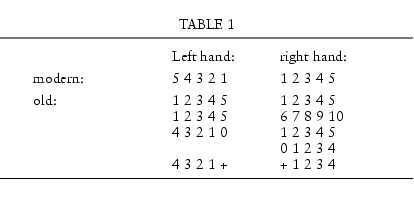
These, and their corresponding versions for the left hand and for all the minor scales, approximate very closely to modern methods. Marpurg also asked that the same fingering should, wherever possible, be maintained for each octave, both ascending and descending.
In view of his progressive approach it is perhaps surprising that Marpurg also retained many features from earlier keyboard technique. In many circumstances he considered crossing the fingers to be ‘more comfortable’ and readily advocated the right-hand fingerings shown in ex.52, provided they were used ‘without stiffness or distortion of the fingers’. M.J.F. Wiedeburg in Der sich selbst informirende Clavier-spieler (1765) mentioned that the left hand employed the passing of the thumb more freely than the right. The position at the keyboard described in various tutors of the period may have been partly responsible for this discrepancy. Marpurg, like Couperin, asked that the body, while adjacent to the middle of the keyboard, should be turned slightly to the right, with the knees apart and the right foot turned outwards. This enabled the little finger of the left hand and the thumb of the right to be held well towards the front end of the black keys, and clearly simplified the execution of the method preferred by Bach. The avoidance of the thumb when playing in keys with few sharps and flats was also governed by the comparatively short distance from the end of the black key to the end of the white on instruments of that period.

While the crossing of fingers persisted in some tutors until the end of the 18th century, there is clear evidence that the technique gradually became less widespread. In the fourth edition of Die Kunst das Clavier zu spielen (1762) Marpurg revised some of his own earlier such fingerings on the grounds that they were two awkward and uncomfortable. The growing tendency to restrict the crossing of fingers to 3 and 4 may be noticed also in Georg Friedrich Wolf’s Kurzer aber deutlicher Unterricht im Klavierspielen (1783) and Türk’s Clavierschule (1789). It is apparent that by that time the older manner was retained in many sources for its historical interest rather than its practical value. Yet J.H. Knecht in his Vollständige Orgelschule für Anfänger und Geübtere (1795) remarked that many players had not grasped the true necessity of using the thumb and little finger and that the earlier troublesome manner still persisted. As a consequence perhaps of their continuing devotion to the clavichord and their preference for the light touch of the Viennese piano, German keyboard players adhered to the old scale fingerings longer than their French, Italian and English contemporaries. Niccolo Pasquali, in The Art of Fingering the Harpsichord (?1760), said that in passages of more than five consecutive notes ‘a proper manner of shifting the hand higher or lower’ could be derived only ‘from the right management of the thumb’. His treatise gained wide circulation and popularity, and within a very short time most English teachers, like Robert Broderip in his Plain and Easy Instructions for Young Performers on the Piano-forte or Harpsichord (c1788), agreed that the long fingers should ‘never be turned over or under each other’. The preference for the ‘thumbs-under’ technique in England was also reflected in John Casper Heck’s The Art of Fingering (c1766). On the title-page Heck acknowledged his indebtedness to the ‘celebrated C.P.E. Bach of Berlin’, and in many practical examples he closely followed Bach’s methods. He did, however, omit all paired fingerings from his scale exercises.
The elimination of older fingering methods was hindered by some degree of inconsistency regarding the use of the thumb. In his suggestions for the right-hand scale of D minor, for example (ex.53), C.P.E. Bach had allowed the thumb to be passed after either 4 or 3, and expressed a preference for the former. The main point at issue seems to have been the use of 5, which was evidently employed less readily than the thumb. Despite his rule that 5 should be held ‘in reserve in stepwise passages, and used only at the beginning or when a run happens to terminate with it’, Bach usually preferred the methods that excluded that finger entirely. Also, his rule that in scale passages the thumb should be used after one or more black keys had resulted in some curious left-hand fingerings, e.g. in the scale of A major (see ex.53), where the ‘most useful’ method is given directly below the notes).

Few teachers were directly influenced, however, by this aspect of Bach’s Versuch, and when J.C.F. Rellstab published his Anleitung für Clavierspieler, den Gebrauch der Bachschen Fingersetzung, die Manieren und den Vortrag betreffend (1790), he took the opportunity of correcting the weakness in this aspect of Bach’s method. He treated the rule appertaining to the use of the thumb as a general observation, and revised the fingerings accordingly. In the case of the A major scale (ex.53) he dismissed the ‘unnatural’ fingering preferred by Bach in favour of the second method, and in this way took a further vital step towards establishing the scale fingerings that have persisted until the present day as the basis of a clean and reliable keyboard technique. The transition to modern scale fingerings was completed at the turn of the century, when Milchmeyer, Adam, Dussek, Clementi, A.E. Müller and other teachers writing specifically for the piano finally discarded the older methods. The new principles of fingering were dealt with in several early 19th-century tutors, including those by Guthmann, Jean Jousse, Czerny and Charles Neate.
Since methods of fingering are, of course, closely allied to differing styles of keyboard compositions, it is only natural that more complex figurations of 19th-century piano music should have been accompanied by a more resourceful approach to problems of fingering. Yet the rules established during the latter part of the 18th century remained a firm basis for all subsequent developments. Czerny in his Complete Theoretical and Practical Pianoforte School op.500 (1839) advocated that, except in special circumstances (such as those obtaining in Chopin’s Etude in A minor op.10 no.2), the long fingers should never be crossed over or under each other; the thumb is the sole pivot of the hand, and unnecessary changes of hand position should be avoided. The same finger should not normally be employed on two or more consecutive keys; this is permissible, however, between phrases, when rests intervene, in staccato passages, or when sliding a finger from a black to a white key. The thumb and little finger should not be placed on black keys in scalic passages, and only out of necessity in other figurations. He also advocated that when the same note is repeated several times the fingers should be alternated, and conversely that to maintain a legato style it is often expedient to change fingers on a note without sounding it again. In sequential passages, the same fingering should, if possible, be repeated to secure a perfect equality of execution; contraction of the hand is frequently essential. Arpeggio figurations, he said, are generally fingered according to the octave span between the thumbs and little fingers, the choice of intermediate fingers being governed by the natural fall of the hand in this extended position. The fingering for passages in 3rds and 6ths should relate to the articulation prescribed by the composer (ex.54). Finally, Czerny recommended the glissando for fast unison, 3rd, 6th or octave passages lying solely on the white keys, a technique that had already been accepted in late 18th-century schools of keyboard playing.

With the exception of the glissando and such devices as Czerny’s of striking one key with two fingers simultaneously, the rules given by early 19th-century teachers were intended primarily to secure a quiet and steady hand position. It was generally agreed that the action of the fingers should be entirely independent of the hands and arms and that the latter should merely serve to convey the fingers laterally from one part of the keyboard to another. The more expansive keyboard style of the mid-19th century, however, required greater freedom and encouraged players to supplement their technique with movement other than simply that of the fingers. Ex.55 shows that this was the case for Chopin, of whom Niecks reported: ‘With one and the same finger he took often two consecutive keys (and this not only in gliding down from a black to the next white key), without the least interruption of the sequence being noticeable. The passing over each other of the longer fingers without the aid of the thumb … he freely made use of, and not only in passages where the thumb stationary on a key made this unavoidably necessary.
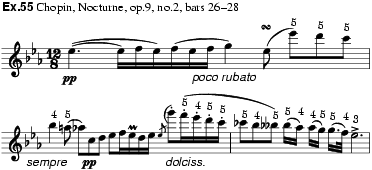
While earlier teachers had discouraged the use of 1 and 5 on black keys because of the excessive hand movement that this entailed, teachers of the later 19th century recommended that the technique should be employed quite freely. For this reason, Louis Plaidy in his Technische Studien für das Pianofortespiel (1852) invited advanced players to transpose the basic C major finger exercises into other keys, using the same fingering, ‘in order that the hand may become accustomed to an equal and certain touch in different positions’. J. Alsleben, writing in Mendel’s Musikalisches Conversations-Lexikon (1873), even stated that the conventional C major fingering could be applied to all scales, including those starting on a black key, and argued that the passing of the thumb in such circumstances was merely a question of practice. These exceptional methods, however, have never superseded the fundamental techniques of fingering established by earlier masters.
Fingering, §I: Keyboard fingering.
|
H. Buchner: Fundament Buch (CH-BU F.i.8a); T. Tallis: Felix namque (GB-Lbl Royal 24.d.3); W. Byrd: Fortune (En Panmure 9; Lbl Royal 24.d.3); The Carman’s Whistle (Lbl Add 30486); Qui passe (Lbl Add 30485; Lbl Royal 24.d.3); J. Bull: Miserere (Och 1207; F-Pc rés 1186 bis ii); various preludes (GB-Lbl Add 31403; Lcm 2093; Cu Dd.4.22 8); Fantastic Pavan (F-Pc rés 1185; GB-Cfm 32.G29); Quadran Pavan (F-Pc rés 1185; GB-Lbl Royal 24.d.3); other pavans, almans, galliards, etc. (F-Pc rés 1185; GB-Lbl 36661); O. Gibbons: Preludium (Och 89; HAdolmetsch, II.E.17 no.36; F-Pc rés 1186 bis ii); Fantasia (GB-Och 378; F-Pc rés 1186 bis ii); Whoop, do me no Harm, Good Man (GB-Och 431; F-Pc rés 1186 bis ii); The Woods so Wild (GB-Lbl Add 36661); The Italian Ground (Lbl Add 36661); J.P. Sweelinck: Fantasias and Toccatas (D-BDS Lynar A1; ed. G. Leonhardt, 1968); R. Mesangeau: Allemande (DK-Kk Kgl Saml 376, 2); anon.: 5 preludes, 7 voluntaries, etc. (GB-Lcm 2093; ed. M. Boxall, 1980); T. Tomkins: Prelude, Galliard, etc. (F-Pc rés 1122); For Edward, etc. (GB-Ob mus sch c.93); G.G. Nivers: Livre d’orgue (Paris, 1665/R; ed. C. Vervoitte, 1862 and N. Dufourcq, 1963); anon.: Praelude oder Applicatio der rechten und linken Hand (D-LÜr kn 149); A. Raison: Livre d’orgue (Paris, 1688/R; ed. A. Guilmant, 1899 and N. Dufourcq, 1962); D. Croner: Applicaturae (RO-BRm 808); J.C. Kittel: 12 Praeamb. durch alle Claves auf Clavichordien und Instrum.: zu gebrauchen (BRm 808); W. Fabricius: Kurtze Praeambula vor Incipienten durch alle Claves (US-Cn Case MS VM 7.F 126); H. Purcell: A Choice Collection of Lessons for the Harpsichord or Spinet (London, 1696); J.-F. Dandrieu: Pieces de clavecin courtes et faciles (Paris, 1713); G.F. Handel: Ciacona, hwv435 (GB-Lbl Add 35177; ed. T. Best, 1979); D. Zipoli and anon.: untitled minuet (Cfm 57); A. Scarlatti: Toccata primo (sic) (Lbl Add 14244; I-Nc 34.6.31); A.B. Della Ciaia: Sonata per cembalo … opera quarta (Rome, ?1727); J.S. Bach: Prelude et Fugetta (sic), bwv870a, (D-Bs P 1089); Applicatio, bwv994, Praeambulum, bwv930, in Clavier-Büchlein for Wilhelm Friedemann Bach (US-NH); Canzona, bwv588 (D-Le, 7, part 21; ed. in Faulkner, 1984); M. Corrette: Premier livre de pieces du clavecin (Paris, 1734); C.P.E. Bach: Kurze und leichte Klavierstücke mit veränderten Reprisen und beygefügter Fingersetzung (Berlin, 1766–8); VI sonatine nuove, h292–97, w63b (Hamburg, 1786) |
Fingering, §I: Keyboard fingering.
J. Bermudo: El libro llamado declaración de instrumentos musicales (Ossuna, 1555/R)
T. de Santa María: Arte de tañer fantasía (Valladolid, 1565/R; Eng. trans., 1991)
E.M. Ammerbach: Orgel oder Instrument Tablatur (Leipzig, 1571, 2/1583); ed. C. Jacobs (Oxford, 1984)
E.M. Ammerbach: Ein new künstlich Tabulaturbuch (Leipzig, 1575)
A. de Cabezón: Obras de música para tecla, arpa y vihuela, ed. H. de Cabezón (Madrid, 1578; ed. in MME, xxvii–xxiv, 1966)
G. Diruta: Il transilvano dialogo sopra il vero modo di sonar organi, et istromenti da penna, i (Venice, 1593/R); Eng. trans., ed. M.C. Bradshaw and E.J. Soehneln (Henryville, PA, 1984)
A. Banchieri: L’organo suonarino (Venice, 1605, 3/1622); Eng. trans., in D.E. Marcase: Adriano Banchieri: L’organo suonario (diss., Indiana U., 1970)
A. Banchieri: Conclusioni nel suono dell’organo (Bologna, 1609/R, 2/1626 as Armoniche conclusioni nel suono dell’organo; Eng. trans., 1982)
F. Correa de Arauxo: Libro … intitulado Facultad organica (Alcalá, 1626; Eng. trans., ed. J.B. Holland, 1989, as Francesco Correa de Arauxo’s ‘Faculdad organica’: a Translation and Study of its Theoretical and Pedagogical Aspects)
J. Nenning [Spiridion]: Nova instructio pro pulsandis organis, spinettis, manuchordiis (Bamberg, 1669–75)
D. Speer: Grund-richtiger … Unterricht der musicalischen Kunst, oder Vielfaches musicalisches Kleeblatt (Ulm, 1697; Eng. trans., 1971)
M. de Saint-Lambert: Les principes du clavecin (Paris, 1702/R; Eng. trans., 1984)
J.B. Samber: Manuductio ad organum (Salzburg, 1704)
F. Gasparini: L’armonico pratico al cimbalo (Venice, 1708/R; Eng. trans., 1963)
F. Couperin: L’art de toucher le clavecin (Paris, 1716, 2/1717; Eng. trans., 1974)
J.-P. Rameau: Traité de l’harmonie reduite à ses principes naturels (Paris, 1722; Eng. trans., 1737); ed. and Eng. trans., P. Gossett (New York, 1971)
J.-P. Rameau: Pieces de clavecin avec une méthode sur la mécanique des doigts (Paris, 1724, rev. 1731 as Pièces de clavecin avec une table pour les agréments)
J.-P. Rameau: Dissertation sur les différentes méthodes d’accompagnement (Paris, 1732)
J. Mattheson: Kleine General-Bass-Schule (Hamburg, 1735/R)
F.A. Maichelbeck: Die auf dem Clavier spielende … Caecilia (Augsburg, 1738)
L.C. Mizler von Kolof: Anfangs-Grunde des General Basses (Leipzig, 1739/R)
M. Corrette: Les amusements du Parnasse, méthode courte et facile pour apprendre à toucher le clavecin (Paris, 1749, enlarged 2/1779)
Hartung [P.C. Humanus]: Musicus theoretico-practicus (Nuremberg, 1749)
Prencourt: Short, Easy & Plaine Rules (GB-Lbl Add 32351)
F.W. Marpurg: Die Kunst das Clavier zu spielen (Berlin, 1750, enlarged 4/1762/R; Fr. trans., Berlin, 1756/R, as Principes du clavecin, 2/1760)
C.P.E. Bach: Versuch über die wahre Art das Clavier zu spielen, i (Berlin, 1753/R, 2/1787; Eng. trans., 1949)
F.W. Marpurg: Anleitung zum Clavierspielen (Berlin, 1755, 2/1765/R; Eng. trans., ed. E.L. Hays, 1976, as F.W. Marpurg’s ‘Anleitung zum Clavierspielen’, (Berlin, 1755) and ‘Principes du clavecin’, (Berlin, 1756): Translation and Commentary)
J. Adlung: Anleitung zu der musikalischen Gelahrheit (Erfurt, 1757, 2/1783)
N. Pasquali: The Art of Fingering the Harpsichord (Edinburgh, ?1760)
G.S. Löhlein: Clavier-Schule, i (Leipzig and Züllichau, 1765; 8/1825, ed. C. Czerny; 9/1848, ed. F. Knorr)
M.J.F. Wiedeburg: Der sich selbst informirende Clavier-spieler (Halle and Leipzig, 1765–75)
J.S. Petri: Anleitung zur practischen Musik (Lauban, 1767, 2/1782)
J.P. Kirnberger: Grungsätze des Generalbasses (Berlin, 1781/R)
A.F. Petschke: Versuch eines Unterrichts zum Klavierspielen (Leipzig, 1785)
D.G. Türk: Clavierschule (Leipzig and Halle, 1789, enlarged 2/1802/R; Eng. trans., 1982)
F.S. Sander: Kurze und gründliche Anweisung zur Fingersetzung für Clavierspieler (Breslau, 1791)
J.H. Knecht: Vollständige Orgelschule (Leipzig, 1795–8)
A.E. Müller: Anweisung zum genauen Vortrage der Mozartschen Clavier-Concerte (Leipzig, 1796)
M. Clementi: Introduction to the Art of Playing on the Piano Forte (London, 1801, 11/1826)
J.C. Kittel: Der angehende praktische Organist, i (Erfurt, 1801–8)
L. Venegas de Henestrosa: Libro de cifra nueva (Alcalá, 1557; ed. in MME, ii, 1944)
P. Prelleur: The Harpsichord Illustrated and Improved (London, c1730)
J.-J. Rousseau: Dictionnaire de musique (Geneva, 1768/R; Eng. trans., 1771, 2/1779/R)
J.N. Forkel: ‘Litteratur und Praxis der neuern Musik’, Allgemeine Litteratur der Musik (Leipzig, 1792/R), 326, 331
J.N. Forkel: Über Johann Sebastian Bachs Leben, Kunst und Kunstwerke (Leipzig, 1802/R; Eng. trans., 1820, 2/1920)
C. Czerny: Erinneringen aus meinem Leben (A-Wgm, 1842); ed. W. Kolneder (Baden-Baden, 1968); Eng. trans., MQ, xlii (1956), 302–17
ApelG
‘M.L. A.’: ‘Old English Fingering’, MT, xxxvi (1895), 152–5
H. Keller: Die musikalische Artikulation insbesonder bei Joh. Seb. Bach (Stuttgart, 1925; Eng. trans., 1965)
M. Schneider: Die Orgelspieltechnik des frühen 19. Jahrhunderts in Deutschland (Regensburg, 1941)
E. Harich-Schneider: The Harpsichord: an Introduction to Technique, Style and the Historical Sources (Kassel, 1954, 3/1973)
N.W. Powell: Early Keyboard Fingering and its Effect on Articulation (diss., Stanford U., 1954)
L. Schierning: Die Überlieferung der deutschen Orgel- und Klaviermusik aus der ersten Hälfte des 17. Jahrhunderts (Kassel, 1961)
S. Babitz: ‘On Using Early Keyboard Fingering’, Diapason, xl (1969), no.3, pp.15–28; no.4, pp.21–26; no.5, pp.21–24
M. Boxall: English Keyboard Technique up to the Death of Henry Purcell (thesis, U. of London, 1970)
J. Rodgers: Early Keyboard Fingering, ca. 1520–1620 (DMA diss., U. of Oregon, 1971)
H. Ferguson: Keyboard Interpretation from the 14th to the 19th Century (London, 1975)
C. Hogwood: ‘Sources for the Performance of French Keyboard Music’, French Music and the Fitzwilliam, Fitzwilliam Museum, May – June 1975 (Cambridge, 1975), 23–30 [exhibition catalogue]
J. Bamberger: ‘The Musical Significance of Beethoven’s Fingerings in the Piano Sonatas’, Music Forum, iv (1976), 237–80
M. Boxall: ‘Girolamo Diruta’s “Il Transilvano” and the Early Italian Keyboard Tradition’, English Harpsichord Magazine, i/6 (1976), 168–72
D. Fuller: ‘French Harpsichord Playing in the Seventeenth Century: after Le Gallois’, EMc, iv (1976), 22–6
T. Koopman: ‘“My Ladye Nevell’s Booke” and Old Fingering’, English Harpsichord Magazine, ii/1 (1977), 5–10
M. Boxall: ‘New Light on the Early Italian Keyboard Tradition’, English Harpsichord Magazine, ii/3 (1978), 71–2
C.L. Lister: Traditions of Keyboard Technique from 1650 to 1750 (diss., U. of North Carolina, 1979) [incl. facs. of M. Corrette: Les amusements du Parnasse]
M. Boxall: ‘The Harpsichord Master of 1697 and its Relationship to Contemporary Instruction and Playing’, English Harpsichord Magazine, ii/8 (1981), 178–83
P. Le Huray: ‘English Keyboard Fingerings in the 16th and Early 17th Centuries’, Source Materials and the Interpretation of Music: a Memorial Volume for Thurston Dart, ed. I. Bent (London, 1981)
P. Le Huray, ed.: The Fingering of Virginal Music (London, 1981)
B. Sachs and B. Ife, eds.: Anthology of Early Keyboard Methods (Cambridge, 1981)
E. Fadini and others: ‘La tecnica esecutiva degli strumenti a tastiera e del liuto nelle fonte storiche’, Praxis, i (1983), 115–53
E. Kooiman: ‘Eine Quelle zu Bachs Klaviertechnik’, Ars organi, xxxi (1983), 21–6
R. Parkins: ‘Keyboard Fingering in Early Spanish Sources’, EMc, xi (1983), 323–31
J.-C. Zehnder: ‘Organ Articulation in the 17th and 18th Centuries’, American Organist (1983), 27–31
A. Bellasich and E. Fadini: ‘Diteggiatura’, Il clavicembalo: organologia, accordatura, notazione, ed. S. Leschiutta and others (Turin, 1984), 161–225
Q. Faulkner: J.S. Bach’s Keyboard Technique: a Historical Interpretation (St Louis, 1984)
M. Lindley: ‘Keyboard Technique and Articulation’, Bach, Handel and Scarlatti: Tercentenary Essays, ed. P. Williams (Cambridge, 1985), 207–43
E.F. Hiebert: ‘Beethoven’s Fingerings in the Piano Trio in B-flat Major, WoO 39’, Early Keyboard Journal, iv (1985–6), 5–27
J. van Oortmerssen: A Guide to Duo and Trio Playing: Studies in Historical Fingering and Pedalling for the Organ (Sneek, 1986)
J. Brock: Introduction to Organ Playing in 17th- and 18th-Century Style (Greensboro, NC, 1988)
Q. Faulkner: ‘Griepenkerl on J.S. Bach’s Keyboard Technique’, American Organist, xxii (1988), 63–5
M. Lindley: ‘Early English Keyboard Fingerings’, Basler Jb für Musikpraxis, xii (1988), 9–26
S.P. Rosenblum: Performance Practices in Classic Piano Music (Bloomington, IN, 1988)
M. Lindley: ‘Early Fingerings: Some Editing Problems and Some New Readings for J.S. Bach and John Bull’, EMc, xvii (1989), 60–69
M. Lindley and M.Boxall, eds.: Early Keyboard Fingerings (London, 1992)
V. Brookes, ed.: Priscilla Bunbury’s Virginal Book (Albany, CA, 1993)
M. Lindley: Ars Ludendi: Early German Keyboard Fingerings/Frühe deutsche Fingersätze für Orgel- und Klavier-Instrumente (Thelkow, 1993)
M. Lindley: ‘Handelian Keyboard Fingerings’, Göttinger Händel-Beiträge, vi (1996), 194–205
Fingering on string instruments involves the stopping of the strings and is therefore more closely allied to intonation, tone-colour and expression than it is on keyboard instruments. Fingering systems and conventions have changed from one period to another in response to other changes: in the instruments themselves, in the material out of which strings are made, in the manner in which instruments were held and in musical taste (see also Position).
Early viol fingerings are based on the left-hand technique of the lute, whose strings are tuned mainly in 4ths, like those of the viol, and whose fingerboard is similarly fretted. Among the earliest treatises dealing in detail with viol fingerings is the second volume of Ganassi dal Fontego’s Regola rubertina (1543) in which some of the examples are written in Italian lute tablature (for an explanation, see Tablature, §3(ii), esp. fig.5
), and fingering is indicated by the placement of dots in four different positions around the fret number (fig. 4). Ganassi’s fingerings are remarkably flexible and farsighted, and include advice for playing in high positions above the frets (for examples see Viol, §3).
One
of the most distinguished 17th-century books on English viol playing was
Christopher Simpson’s The Division-Violist (1659). In his important
advice on fingering Simpson suggested using 3 or 4 for the highest note when
playing above the frets; in his exercises (but never in his pieces), he also
gave specific fingerings including ex.56; the asterisk above the 4th finger on
the d' points out to the beginner that this is an alternative fingering
(the note could be played on an open string), a technique later known as
‘creeping’ (in this case the substitution of 3 for 4 on the second C![]() ). He advised that fingers
should be allowed to remain on the strings as long as possible during playing,
both for the ‘better ordering of fingering; that the Fingers may pass more
smoothly from Note to Note … as also, to continue the sound of a Note when the
Bow hath left it’. The concept of the ‘hold’ or the tenue was extremely
important to viol technique and is mentioned in nearly every treatise concerned
with the viol.
). He advised that fingers
should be allowed to remain on the strings as long as possible during playing,
both for the ‘better ordering of fingering; that the Fingers may pass more
smoothly from Note to Note … as also, to continue the sound of a Note when the
Bow hath left it’. The concept of the ‘hold’ or the tenue was extremely
important to viol technique and is mentioned in nearly every treatise concerned
with the viol.
![]()
Jean Rousseau’s Traité de la viole (1687) is very detailed in all aspects of technique. With his contemporary Sainte-Colombe, there began a line of composer-players whose musical works are carefully marked with fingerings, bowings, dynamics, ornamentation signs and precisely written-out embellishments. The pièces de violes of Marin Marais and Antoine Forqueray, with their meticulously worded prefaces, constitute a precise school of viol playing unsurpassed in virtuosity. In his five books of viol pieces (1686–1725) Marais insisted that the performer follow his fingerings exactly, and the fact that so many notes are fingered leaves very little possibility of confusion – or even of choice. John Hsu categorizes the possible finger placings as shown in ex.57.
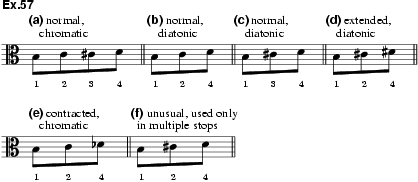
Practice and most sources bear out Hsu’s analysis that the fingering system on the bass viol generally requires one finger for each semitone, with occasional extensions of a tone, almost always between 1 and 2. The treble viol, however, being half the size of the bass, is sometimes played with one finger for each tone. Danoville mentions such differences in fingering in L’art de toucher le dessus et basse de violle (1687/R) and Corrette devotes several chapters to fingerings on the pardessus in his Méthod pour apprendre facilement à jouer du par-dessus de viole (1748).
Two important fingering signs used by French viol masters are shown in ex.58 and demonstrated in context in exx.58 and 59: the sign for the tenue is shown in ex.58a. Another important fingering, allied to the principle of tenue, is the doigt couché, mentioned by Marais in the avertissement of his first book of pièces de violes (1686), for which he used the sign shown in ex.58b (Ganassi and Simpson also described it but did not use this term). Derived from lute technique (see Barré), it involved placing the first finger, or very occasionally the fourth, across two or more strings, allowing the other three fingers to remain free to stop other notes. This is often needed when playing chords and arpeggios, and also in certain other passages in order to maintain the tenue principle. Another sign sometimes used by Marais to clarify fingering consists of a number of dots arranged around the finger number) indicating which string to play the note on: for example, the f that opens ex.59 should be fingered by 4 on the 4th string and the g at the beginning of ex.60 should be fingered by 4 on the 2nd string. Bol (1973) summarized the fingering rules of the period as follows: (1) in broken chords, the lower and upper notes are held as long as possible so that the sound may continue after a note is no longer bowed; (2) if possible, the same finger should not be used for two different notes on the same fret (except in le doigt couché); (3) a change of position is rarely made during a single bow stroke except by means of an open string, extension or ‘le système-reptiles’ (creeping); (4) in a shift which moves by step, the finger which was used last in the position the player is leaving is used first, if possible, in the new position (see ex.59); (5) if two or more fingers are placed on the same fret, the lowest numbered finger normally plays on the lowest string.
![]()
![]()
![]()
Modern tutors for the viol, with instructions on fingering, have appeared in response to a revival of interest in early instruments. However, many players today continue to base their fingerings on Simpson, Marais, Forqueray and their contemporaries.
Fingering, §II, 3: Bowed strings: Violoncello
The conventions for indicating fingering in violin, viola and cello music were not completely standardized until well into the 18th century. Nevertheless, the basic system (unlike modern keyboard practice) has always involved numbering the fingers from 1 for the index finger to 4 for the little finger. As with so many questions of performance practice, the most obvious sources of information regarding fingering systems in violin music from 1600 to 1800 are instruction manuals. For the second half of this period, these may be usefully supplemented by marked fingerings in printed collections of violin sonatas.
The
earliest instructions for violin fingering are found in Mersenne's Harmonie
universelle (1636–7). Mersenne marked the notes assigned to each finger in
1st position, advocating the use of the same finger for any note and for its
chromatically-altered version (i.e. 2 for b![]() and b on the G string, 3 for g'
and g
and b on the G string, 3 for g'
and g![]() ' on the
D string etc.). The primary function of the little finger (except on the E
string where it has a greater role) was to produce the flattened version of the
notes available as open strings (d
' on the
D string etc.). The primary function of the little finger (except on the E
string where it has a greater role) was to produce the flattened version of the
notes available as open strings (d![]() ' etc.). Although he did not attempt any explanation
of shifting, he indicated that the range of the violin extended to d'''
on the E string. Many later publications are less sophisticated, none more so
than that most amateur of all violin treatises, John Playford's Introduction
to the Skill of Music (7/1674) which recommends that beginners fret their
instruments and place one finger behind each fret (thus giving semitone
fingering). Not until the great violin treatises of the mid-18th century
(Geminiani, Leopold Mozart, Herrando, and L'abbé le fils) is a more
advanced picture of left-hand technique promulgated. The advice given by both
John Lenton (The Gentleman's Diversion, or the Violin Explained, 1693)
and Michel Corrette (L'école d'Orphée, 1738), for example, is
essentially the same as Mersenne's (though Corrette does describe positions up
to the 7th and acknowledges the possibility of shifting on all strings).
' etc.). Although he did not attempt any explanation
of shifting, he indicated that the range of the violin extended to d'''
on the E string. Many later publications are less sophisticated, none more so
than that most amateur of all violin treatises, John Playford's Introduction
to the Skill of Music (7/1674) which recommends that beginners fret their
instruments and place one finger behind each fret (thus giving semitone
fingering). Not until the great violin treatises of the mid-18th century
(Geminiani, Leopold Mozart, Herrando, and L'abbé le fils) is a more
advanced picture of left-hand technique promulgated. The advice given by both
John Lenton (The Gentleman's Diversion, or the Violin Explained, 1693)
and Michel Corrette (L'école d'Orphée, 1738), for example, is
essentially the same as Mersenne's (though Corrette does describe positions up
to the 7th and acknowledges the possibility of shifting on all strings).
The general acceptability of the timbre of open strings is one of the most obvious ways in which 17th-century performance practice differed from othodox modern playing. The preference for a fingered alternative to the open string emerged as an important new refinement early in the 18th century. Roger North commended this practice as the most important of ‘certein late manners of touch introduc't – the result of the nicest skill and ability’. François Duval (Les idées musiciennes, 1720) and Pietro Castrucci (Sonate, op.2, 1734) specified fourth fingers where no player trained in 20th-century technique would think of using anything else. F.M. Veracini (Sonate accademiche, 1744) marked fourth fingers while leaving far more difficult technical problems unaddressed. By the second half of the 18th century (when Sir John Hawkins could refer to ‘the disgusting clangor of an open string’) good players tended to favour stopped notes. Leopold Mozart said that open strings were ‘too loud compared with stopped notes and pierce the ear too sharply’ (Versuch einer gründlichen Violinschule, 1756). Fourth-finger extensions were also noted in treatises and specified in printed music. Gasparo Zanetti, whose rather crude tablature in II scolaro … per imparar a suonare di violino, et altri stromenti (Milan, 1645) depends on the use of fingering numbers, used the figure 5 to indicate occasional extensions to c''' on the E string. This stratagem was adopted (coincidentally) by Castrucci, who used 5 to indicate an extension for the highest note in what is otherwise a passage to be played entirely in 5th position (ex.61). Later, composers showed extensions by fingering both the note of the extension itself and the note immediately following to re-establish the basic position (ex.59d). L'abbé le fils (Principes du violon, 1761) placed the letter e above the number for the finger involved to indicate an extension (ex.62).
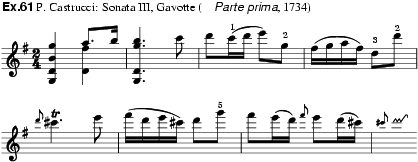
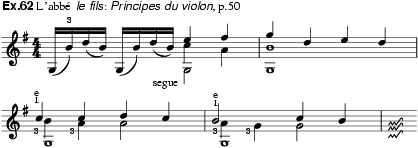

2nd
position (referred to as ‘half-position’ by Mozart, Herrando and others) was
also specified in sonata collections, whereas 3rd-position passages (considered
less remarkable) were often left unfingered. Piani's sonata collection of 1712,
the earliest to contain printed fingerings, is a case in point. Likewise,
Jean-Baptiste Miroglio (op.1, before 1750 and op.2, 1750) provided fingerings
only for 2nd position passages. J.-A. Mathieu introduced the second and fourth
sonatas of his op.4 (1764) with a rubric saying that they can be played in 2nd
position. Less is said about what we now call ‘half position’. Leclair le
cadet indicated it in 1739 (ex.63). L'abbé le fils was the first to
discuss the concept properly in his Principes du violon. He introduced
it by showing that keys on sharp tonics (G![]() minor, F
minor, F![]() major etc.) often call for ‘borrowed fingers’, meaning
that these fingers are applied to notes other than those ‘normally’ assigned to
them in 1st position. He stressed that in playing passages of this type the
hand should not be shifted (i.e. half-position should be regarded as an
extension backwards from 1st position).
major etc.) often call for ‘borrowed fingers’, meaning
that these fingers are applied to notes other than those ‘normally’ assigned to
them in 1st position. He stressed that in playing passages of this type the
hand should not be shifted (i.e. half-position should be regarded as an
extension backwards from 1st position).
![]()
The problem of how to finger passages in upper positions and, more particularly, how to shift to and from these positions was one which Mondonville ruefully admitted in his preface to Les sons harmoniques (1738) ‘often discourages most of my followers’. Geminiani (The Art of Playing on the Violin, 1751) was quite systematic in his treatment of the difficulties of shifting. His scales utilising only a pair of fingers (especially one based on fingers 1 and 4) help develop a very flexible hand. Altogether, his instructions emphasize the independence of the thumb and fingers. He maintained that the thumb should be left behind, so to speak, as the hand moves into upper positions while, for downward shifts, the fingers should move first with the thumb following: ‘it must be observed that in drawing back the Hand from the 5th, 4th and 3rd Order to go to the first, the Thumb cannot, for Want of Time, be replaced in its natural Position; but it is necessary it should be replaced at the second Note’. No other writer was quite so helpful in dealing with the mechanics of shifting. Herrando (Arte y puntual explicación del modo de tocar el violín, 1756) gave eight pages of scales and exercises for playing in higher positions (including 2nd position, which he regarded as of crucial importance). The English edition of Carlo Tessarini's violin method (c1765) contains a few basic ‘lessons for the whole shift’ etc. The full title of L'abbé le fils's treatise Principes du violon pour apprendre le doigté de cet instrument emphasizes his concern for the question of fingering. The treatise includes a number of useful studies in which fingerings are marked and shifts are indicated by the letter D (for démancher). Corrette's first treatise, L'école d'Orphée, contains two short fantasias for practising in upper positions, but his later volume, L'art de se perfectionner dans le violon (1782) is, in fact, an anthology of difficult passages from well-known virtuoso works such as Vivaldi's Four Seasons with fingerings added. Corrette stressed in his preface to the latter volume the importance of ‘being conversant with all the positions of four strings, having facility in shifting, and playing cleanly and distinctly’.
Leopold Mozart gave recommendations for planning shifts in the most manageable and musically-discrete ways. Downward shifts, for example, could be smoothly executed by waiting for a note which could be played as an open string, or for a repeated note, or for a dotted group where the slight lift of the bow on the dot allows time for a noiseless descent. He also pointed out that ‘it is … easy to descend if similar passages are played with similar fingerings’ (ex.65) Mozart's very orderly exposition of the principles involved in playing in upper positions is, in fact, a codification of the practice of the best violinists of the preceding generation. His rules match perfectly the fingering markings of players like the Leclairs. In the preface to his Premier livre de sonates (1723) Leclair l'aîné explained that he had ‘taken care in certain positions or where the performer might find particular difficulty to mark in the figures for the fingers that should be used’. It is striking how often his fingerings serve as a warning that a shift to a particular position is needed to cope not with an immediate difficulty but with one that is coming up a bar or so later. Several of his fingerings are of the kind that encourage the performer to think beyond the concept of positions (or to use what Mozart termed the ‘mixed position’).

Leclair
le cadet's Premier livre de sonates (1739) is full of virtuoso
passages, for many of which the composer offers fingerings. These often show a
way of shifting down from a high position where the ascent has not been
fingered. Leclair was particularly fond of sequential fingerings, often giving
an easy descent in small stages from a high position (ex.63a). There is a striking economy about his
fingering indications. He inserted fingerings for passages which, though at
first appearing to require shifting, could in fact be played in one position (ex.63b). Often a fingering shows the smallest
possible shift: in ex.63c the performer can get through to a rest
– a natural place to make a large descent – simply by moving the second finger
back a semitone. Similarly in ex.63d an extension is specified for the one
note that lies outside 5th position and an open string is used for the descent
to 1st position. In this case an open-string trill is acceptable. (Later
Tartini was to advise Maddalena Lombardini to begin perfecting this ornament by
practising first-finger trills on open strings.) Elsewhere a change of position
is marked for the sake of a trill on e'', but this is to accommodate a
turn at the end of the ornament (ex.63e). In the same year, Geminiani brought
out the revised edition of his op.1 with added ‘graces for the Adagios, and
numbers for the shifts of the hand’. The copious fingerings cover every
conceivable type of shift (though they still do not solve all the problems in
the difficult fugal movements). The closing bars of the first sonata are
fingered with a shift up to 2 on d''' (thereby avoiding a fourth-finger
trill) followed by a descent in three stages where two would be possible. The
last part of this move back implies the use of an open E string immediately
before the first finger marked on f![]() ''.
''.
Fingerings which indicate that string crossing is intended are almost as common as fingerings for upper positions and shifts. The few fingerings in Leclair l'aîné's Troisième livre de sonates (1734) are all concerned with showing that a particular effect is to be achieved through string crossing. In Sonata VI there are several chords notated in a way which shows that they should be broken downwards; one of these has a fingering added to remove any possible ambiguity about the effect intended (ex.66). There is a particularly interesting example in the second sonata of Jean-Baptiste Cupi (i)'s op.1 (1738), in which a third-finger extension is marked (ex.67) where an open string would disrupt the bowing pattern and where a fourth finger would disturb the ‘frame’ the left hand has adopted for the figure.


There is little specific guidance in the treatises on the fingering of double stops, chords and arpeggios. L'abbé le fils dealt with ‘crossed’ fingering for diminished and augumented 5ths, and later gave exercises for fingering arpeggios on three and four strings which stress the usefulness of extensions – especially backwards with the first finger – for changing position in sequential passages (ex.67). This strategy is indicated in some of the fingerings given by Leclair l'aîné (Premier livre). Leclair le cadet's Premier livre is one of the more interesting sonata collections for its treatment of double stops. He was one of the earliest composers to mark 3rds with adjacent fingers, one of them extended. (ex.68a). Etienne Mangean used the same fingering in several sonatas of his op.3 (1744) and Mozart acknowledged the possibility of this fingering in one of his examples. One of Leclair's passages in 3rds has an extraordinary fingering that seems designed to ensure an audible slide between some of the slurred pairs (ex.68b).
In contrapuntal passages, fingering indications can be used to clarify voice-leading. Mozart illustrated how backward first-finger extensions could be used to ensure that a suspension was properly sustained (ex.69). A fingering for a fugal movement in Geminiani's op.1 (1716) suggests that violinists should not necessarily try to sustain all the notes in contrapuntal passages for their full written value; the notation is designed first and foremost to make the voice-leading clear rather than as a literal instruction to the performer (ex.70a). In several other instances, however, he advocated finger substitution on a sustained note precisely so that it would continue to sound against new notes in another voice (ex.70b).
![]()
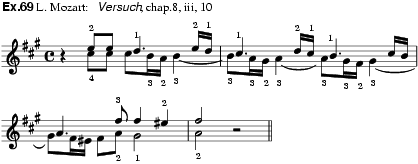
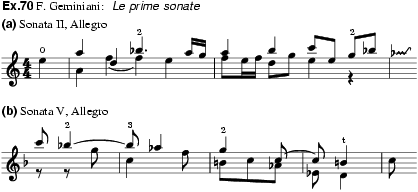
One rather bizarre approach to the ‘fingering’ of chords in the early 18th century was the use of the thumb, as specified by Louis Francoeur in his Premier livre de sonates (1715); (ex.71) The device was adopted by Leclair l'aîné and was one of the features of his playing commented on in the Mercure de France in 1738:

He is the first Frenchman who, imitating the Italians, played double stops, that is to say, played chords of two, three and even – by means of the thumb – up to four notes; and he has taken this kind of playing so far that the Italians themselves acknowledge that he is one of the first in the field.
Leclair marked a passage for the thumb in Sonata XII of his Premier livre (ex.72). The technique was only possible if the violin was held so that the thumb sat well up over the fingerboard, a position which, however unnatural it might seem to modern violinists, seems to have been endorsed by a number of early 18th century paintings and engravings.

The art of fingering is primarily concerned with being able to play as many notes as possible on the fingerboard. However, string players constantly face choices between alternative fingerings. The choice may be a matter of convenience, but is equally likely to be one of colour (notes played in 1st position on the upper strings have a much brighter, clearer tone quality than those fingered in the higher positions on the lower strings). Consideration of tone colour does not seem to have played much of a part in 17th-century fingering, when the practicalities of being able to negotiate a passage efficiently were the overriding concern, but this was to change in the 18th century. Leopold Mozart urged soloists to consider playing entire passages on one string ‘in order to produce consistently the same tone quality’, and in discussing the use of 2nd position he gave an example in which the highest note f'' was to be played on the A string, explaining that ‘in slow pieces the fourth finger is often used, not from necessity but for the sake of equality of tone and therefore also for the sake of elegance’ (ex.73). 18th-century sonata collections occasionally specify fingerings for their particular colour. In Sonata VIII of Leclair le cadet's Premier livre a shift to 4th position a little earlier than strictly necessary corresponds to a change from a section marked ‘fièrement’ to one marked ‘gracioso’ (ex.74).

![]()
The use of harmonics seems to have met with limited approval in the 18th century. Pincherle (1955) speculated that Vivaldi's direction ‘violini in tromba marina’ indicated their use. Mondonville gave a thorough explanation in the preface to Les sons harmoniques though, on the face of it, he recommended them not as a special tone colour but as a way of avoiding difficult shifts when playing high notes. Leopold Mozart scorned their use saying that they resulted in ‘a really laughable kind of music … owing to the dissimilarity of tone’. L'abbé le fils systematically explained the production of natural and artificial harmonics. At about the same time in Paris, Carlo Chiabrano published, under the name Charles Chabran, his Six sonates à violon seul et basse continue op.1, containing instructions for playing harmonics, which are then exploited in two of the sonatas. One of the main concerns in the second volume of Ignaz Schweigl's Verbesserte Grundlehre der Violin (1795) is the use of natural harmonics; like Mozart, he refers to these as ‘flagoletti’.
The bowing techniques Bariolage and ondeggiando have implications for fingering; more often than not, in fact, it is through marked fingerings (rather than any explicit verbal direction) that these devices are indicated. Guillaume Gommaire Kennis (c1740) provided an early instance of this (ex.75). Haydn used bariolage to quite whimsical effect in several of his quartets.

Fingering, §II, 3: Bowed strings: Violoncello
The 19th century brought a demand for bigger sounds and greater virtuosity from violinists and cellists. The practice (established in the early years of the 19th century) of attaching the neck to the body of the violin by a mortised joint in the top-block (see Violin, §I, 2) meant that the combination of the neck and fingerboard no longer increased in bulk towards the ribs of the instrument. This more uniformly slender neck facilitated shifting into and playing in higher positions, and quick passages and the use of high positions on the lower strings became common.
The Italian violinist G.B. Viotti, who went to Paris towards the end of the 18th century, had a great impact on what was to become the French school of violin playing. The Paris Conservatoire was founded in 1795, and in 1803 the official conservatory Méthode de violon, by Pierre Baillot, Pierre Rode and Rodolphe Kreutzer, was published. Together with Baillot’s L’art du violon: nouvelle méthode (1834) it became the model for all future methods. The manner of holding the violin, with the chin to the left of the tailpiece and the instrument rather horizontal, is modern, as is the idea that the left hand should be held away from the neck so that left-hand freedom is guaranteed. (The chin rest, invented by Spohr in about 1820 and, by his own account, finding widespread acceptance by the 1830s, provided additional security for a virtuoso shifting technique.) Scale and arpeggio exercises are given in each of seven positions. There are three-octave chromatic scales with the sliding fingers first advocated by Mersenne (the third octave is fingered 1212121223344), scales in 3rds, double trills in 3rds, and 6ths with alternative fingerings. Not all the fingerings would be acceptable to players today (see ex.76). In Baillot’s method there are studies in octaves and 10ths, broken 10ths and fingered octaves (which, according to Flesch, were invented by Wilhelmj). The many examples from the violin literature of the period include fingerings that show a 19th-century liking for warm, rich sounds produced by lower strings in high positions, and for sliding in both directions.

The Méthode de violon (1858) by Charles-Auguste de Bériot formed the basis of the so-called Franco-Belgian School. His treatment of fingering in the upper positions (which includes the provision of numerous études based on his principles) is encyclopedic and shaped by musical rather than purely functional considerations. (Bériot, incidentally, did not acknowledge the existence of the chin rest in his instructions on holding the instrument; rather, he recommended the application of just enough chin pressure shared between the tailpiece and the belly on the left-hand side, to stabilize the instrument.) His fingerings for chromatic scales were based on the use of each finger in succession, an important step towards present technique.
The innovations of Paganini had tremendous influence on all aspects of violin playing. He rejected the classic concept of positions, thus opening up unlimited possibilities for the left hand. Guhr (c1830) gave many astonishing fingerings used by Paganini to play passages on one string, double stops and chords (ex.77).
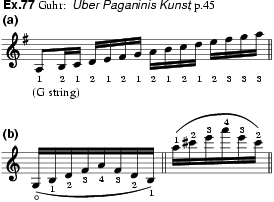
In the 19th century, methods were not the only, or necessarily the most interesting, means of communicating fingering technique and musical style; there were also the many editions by violinists such as H.W. Ernst, Joachim, Ferdinand David, Hubert Léonard and August Wilhelmj. David’s Die hohe Schule des Violinspiels is an astonishing collection of Baroque and Classical works fingered in 19th-century style, with expressive slides, high-position playing on all strings and additions to the original texts of double stops and chords. By the second half of the 19th century, extensions and contractions were well established as means of avoiding unwanted slides and of moving smoothly over the fingerboard. Alternative fingerings were given for scales and arpeggios in many methods. Joachim, for example, suggested that each three-octave diatonic scale, except for those of G and A, should begin with the second finger, but he also advised the student to learn each scale beginning in the 1st position.
Though the viola was comparatively neglected as a solo instrument during the 18th and 19th centuries, its left-hand technique kept pace with that of the violin, as can be seen from the early 19th-century methods, studies and compositions of Antonio Bruni, Bartolomeo Campagnoli and Alessandro Rolla, and from Brahms’s sonatas.
At the beginning of the 20th century, Otakar Ševčík’s publications, dealing with aspects of standard violin technique, were very influential, and they are still used today despite the fact that his placing of the hand in set positions is somewhat outmoded. Perhaps the most important modern book dealing specifically with fingering is Carl Flesch’s Alta scuola di diteggiatura violinistica, which incorporates many ideas from his Die Kunst des Violin-spiels. He rejected the traditional concept of hand positions indicated by numbers and encouraged the player to adapt standard fingerings to his own style and technique. He admitted to a prejudice against stretching (extension), but indicated extension fingerings when they are necessary to avoid slides. He discussed the merits of open strings and fourth fingers in runs, fearing that the new steel E string might cause ‘whistling’. He preferred to play chromatic scales with contiguous fingers and used half-position to avoid slides. Some of these points are illustrated in the fingerings he recommended for passages in works by Kreutzer and Paganini (ex.78).
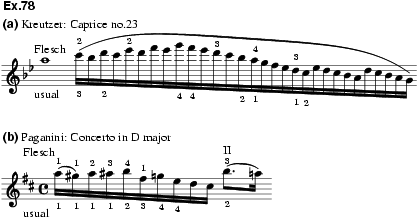
Among the many 20th-century methods and studies including fingering systems Leopold Auer’s Graded Course of Violin Playing (1926) has had enormous influence on left-hand technique. His method is largely for the highly gifted student, and the virtuoso repertory is thoroughly explored. The fingerings are less modern than Flesch’s, and include much use of slides and harmonics. Albert Jarosy, Sol Babitz and others have explored a new theory of fingering based on ‘the natural fall of the fingers’, which on the A string would be represented by ex.79. According to Jarosy, fingering is not an individual matter, and ‘what is needed is a law of fingering, the fundamental rightness of which would dominate all personal methods’ (Jarosy, 1921). His concepts are often contradictory and illogical, but they open up new possibilities, which Babitz has explored, sometimes to a point that many violinists would consider extremely unnatural (ex.80). Nevertheless, Jarosy’s and Babitz’s ideas about contraction, extension and relaxation of the hand are valuable, particularly when dealing with the often formidable difficulties of contemporary music.


Yampol'sky (1933) did not take up such an extreme position, and his book is an intelligent and disciplined survey of both past and present fingering techniques. He set out various fingering principles with great clarity and considered Kreisler’s fingerings to be valuable as the expression of a unique musical personality, even if they were rooted in 19th-century conventions which have since fallen out of fashion. He stressed that the choice of fingering ‘is a creative task, dependent on the musical instincts of the performer and the intellectual and emotional content of the work to be performed – in other words, its interpretation’. Joseph Szigeti also explored the whole subject in considerable depth. His fingerings of examples from Bach to Bartók in his books A Violinist’s Notebook (1964) and Szigeti on the Violin (1969) show his awareness of musical styles, as do also his various editions. His extension fingerings often seem impossible for those with smaller hands than his (ex.81). Ivan Galamian is important as the teacher of many outstanding violinists. His Principles of Violin Playing and Teaching (1962) embodies ideas about fingering which, while not new, have been widely adopted by players anxious to avoid unwanted slides.

Developments in violin fingering apply, by and large, to the viola as well and are enshrined in the methods of Dolejši (1939) and Primrose (1960) and in the 20th-century repertory for the instrument.
There were two early systems of fingering for the cello: fingerings in which semitone spaces occur between each finger in positions below the half-string harmonic, or diatonic fingerings modelled on violin technique in which whole tones may occur between all fingers in the positions of the neck. Early cello technique was strongly influenced by that of the violin and viol, as cellists were often first players of those instruments. The postscripts to Bismantova's Compendio musicale (1694) present fingering for the viola da spalla (one of many terms for the small-sized bass violin) in the manner of the violin, using the fourth finger only on the A string to reach e'. The earliest musical evidence for advanced fingering technique is found in the Ricercate by Degli Antoni (1687) and Domenico Gabrielli's Ricercares for solo cello (1689). The range represented in the Degli Antoni works extends from C to c''; Gabrielli's Ricercares are the first known pieces to incorporate double stopping and chords. Works dating from the 1680s and 90s by Giovanni Bononcini and Antonio Caldara call for fingering in the higher positions of the neck and virtuoso passagework.
Early treatises on playing the cello devote significant space to fingering, as a well-established system of fingering did not at that time exist. Michel Corrette oriented the fingering principles in his Méthode théorique et pratique pour apprendre en peu de tems le violoncelle (1741) towards viol players and violinists taking up the cello for the first time, presenting several fingering options for passages in the lower positions. His fingerings for consecutive note patterns suggest the use of an oblique left-hand position as the use of the fourth finger is eliminated in passages above 3rd position, where the backwards-pointing thumb against the thick neck of the cello would inhibit the use of the fourth finger. Corrette referred to the chromatic system of fingering as an outmoded way of playing, practised on large bass violins and applied to the cello by players of the larger instrument. He described the violin-style fingering of Bononcini as the best system and the most commonly practised at the time. The works of Jean Barrière, published in the 1730s, provide evidence for the use of diatonic extensions without changing position. An example from Sonata no.5, bk 4 (1739) shows rapid arpeggios across two strings within the compass of an octave. Salvatore Lanzetti (Principes ou l'application de violoncelle, before 1770) applied diatonic fingerings to passages in the first two positions, with extensions between the first and second fingers, while for 3rd and 4th positions he advocated Corrette's fingering pattern, in which a whole-tone extension is used between the second and third fingers. Unlike Corrette, Lanzette employed the fourth finger above the half-string harmonic. Lanzetti's solo works also show the use of extensions between the second and third, and third and fourth fingers. An example from Sonata no.10 (12 sonate, op.1, 1736) requires the use of such extensions to execute the rapid passagework neatly without shifting.
As the 18th century progressed, fingerings based on semitone spacing between the fingers, and the use of extensions between the first and second fingers only in lower positions, became more common. However, there were still differences of opinion between schools of playing concerning fingering choices and the position of the left hand on the neck. In his Instructions de musique, théorique et pratique, à l'usage du violoncelle (1774), J.-B. Baumgartner advocated an oblique hand position on the neck, using an extension between the second and third fingers, and eliminating the fourth finger from the 3rd position upwards, where the third finger is recommended instead. The use of thumb position is avoided. On the other hand, the French cellists J.B. Tillière (1764) and J.-B. Cupis (ii) (1772), in their respective treatises, demonstrated consistent principles applied to fingering in the first four neck positions. Both Cupis and Tillière were students of Martin Berteau and applied the principle of chromatic fingering, with extensions used between the first and second fingers only in the first four positions. Above 4th position, the fourth finger is used only exceptionally, and whole-tone extensions between the second and third fingers are applied. Available evidence suggests that the use of a more perpendicular left-hand position in relation to the neck by players of the French school facilitated the use of chromatic fingerings. John Gunn's Theory and Practice of Fingering the Violoncello (1789) was the first attempt to systematize cello fingering. He strongly advocated the use of the perpendicular, as opposed to oblique, position for the left hand. The use of scale fingerings encompassing a minor 3rd between the first and third fingers (using an extension between the first and second), given as an option by Gunn, can be documented to the end of the 18th century, and includes fingerings suggested by J.-B.S. Bréval in his Traité du violoncelle (1804).
The use of thumb position, in which the thumb is placed horizontally across the strings, thereby acting as a moveable nut, is documented in compositions dating from the 1730s. Some of Lanzetti's sonatas, for example, call for a tessitura well above the positions of the neck that could only be played by using thumb position. The discussion of thumb position in Corrette's Méthode suggests its use was well-known by 1741 and that cellists used the technique to play works for the violin as well as virtuoso cello pieces. Thumb position was based on the interval of a 4th between the thumb and the third finger when playing on one string, or an octave when playing on two strings. This octave spacing became the basis from which thumb position developed as a technique to expand the instrument's range and capacity for virtuoso playing. Performance practices emanating from the early Mannheim cellists Innocenz Danzi and Anton Filtz were passed on in Austria and Germany through their students J.G. Schetky, Peter Ritter and J.B. Tricklir. These cellists were highly proficient in the use of thumb position and used the fourth finger over the entire compass of positions, including extensions between the third and fourth fingers. A characteristic feature in their use of the thumb was the employment of blocked hand positions across two or more strings in thumb position, from which a wide range of virtuoso devices could be executed. Works written by or for cellists in the Mannheim tradition, such as Haydn's Concerto in C, contain many passages written to show off this technique.
The codification of the fingering system used by the French school occurred with the publication of J.-L. Duport's Essai sur le doigté du violoncelle (1806). Crediting Berteau with establishing the foundation of cello fingering, Duport's detailed treatment of fingering principles provided the basis for the modern left-hand technique. He advocated a left-hand position that is perpendicular to the neck, with the thumb placed on the neck behind the first and second fingers (the thumb moving with the fingers when shifting), and the use of well-rounded fingers. Like Gunn, Duport expressly advised against using the violin-style oblique position of the left hand on the neck, pointing out its lack of agility in passages in which the hand position must encompass two whole tones between the first and third fingers in quick succession. The overriding left-hand principle presented in the Essai is that of successive semitone spacings between each finger, with extensions possible between the first and second, and between the second and third but only above the 4th position. He occasionally allowed an extension to be taken between the third and fourth fingers but only in exceptional cases, such as specific arpeggio patterns. He strongly advised against sliding on the same finger when changing positions, a common fingering choice in earlier treatises, but which he judged as producing a disagreeable and tasteless effect. His exceptions to this rule are limited to intentional slides on one finger executed for musical reasons, such as the playing of portamento, or broken 3rds, where such slides are necessary in order to maintain the integrity of the hand position. He also advised that changes of bow direction be coordinated with left hand position changes to avoid shifting within slurs. Neatness of execution and purity of tone were of paramount importance to Duport, and he preferred regularity in fingerings to maintain consistency in the left hand technique, thereby affording better intonation.
Duport's fingering principles were disseminated through the Paris Conservatoire method, co-authored by J.-H. Levasseur who was one of his students, and other cellist-contemporaries whom he influenced, such as Nicolas Baudiot, Friedrich Dotzauer and Robert Lindley. A particularly influential teacher, Dotzauer subscribed to Duport's left hand principles and was instrumental in introducing these into the German school of cello playing, as illustrated in his Violoncellschule (1832).
B.H. Romberg's fingering technique differed markedly from that of his contemporary, Duport, as he advocated an oblique position of the left hand. He was particularly known for his skill in thumb position, and he extended the limits of this technique using blocked hand positions, developing a brilliant capacity to play in the upper register on the G and C strings. The frequent use of thumb position on the C string by German cellists sharply distinguishes this school of cello playing from that of the French, who avoided using the C string in solo compositions until after 1815. Unlike Duport, Romberg often used same-finger shifts when changing positions, and the fourth finger in thumb position. The use of the little finger in thumb position lost favour with French cellists through the 18th century and was re-introduced only at the beginning of the 19th century by German players, such as Romberg. Many passages requiring the use of the fourth finger in thumb position can be found in 19th-century works for the cello.
Aspects of the fingering techniques of both Duport and Romberg were amalgamated by the early 19th-century cellist-teachers, Baudiot and Dotzauer. Whereas the thumb position fingering styles of Duport and Romberg were based on blocked positions, other effects became more frequently used than in the 18th century, such as 10ths (e.g. A.F. Servais, Caprice no.6, ?1854), and consecutive shifts on the thumb, including octaves and double stops. The Russian cellist Karl Davïdov adopted the ideas of the violinist Khandoshkin, using a completely mobile hand over the fingerboard without reference to fixed positions based on the thumb, in order to facilitate a more expressive, lyrical style of playing. An important teacher as well as performer, Davïdov's fingering style had lasting influence in Russia throughout the second half of the 19th century. Friedrich Grützmacher's Hohe Schule des Violoncellspiels (1891) was also influential, reflecting 19th-century German taste for slides, harmonics and rich sonorities. David Popper employed the 19th-century German fingering system to its fullest potential, his pedagogical and musical works extending the compass of thumb position, using logical, fixed positions, to the highest possible range.
Pablo Casals is credited with taking the best aspects of earlier methods of fingering and developing them into the modern left-hand technique. Although Casals never published a method on cello playing, two of his pupils, Diran Alexanian and Maurice Eisenberg, wrote detailed expositions on cello playing and technique that were based on Casals's principles and received his approbation. Noteworthy aspects of Casals's fingering principles include his approach to the use of extensions, various means of shifting, and techniques for fingering chords and double stops. Extensions are normally only used between the first and second fingers, but are not limited to the interval of a tone, as larger extensions may be taken in cases where an extension is preferable to a shift. When changing position by ascending from a lower to a higher finger, or descending from a higher finger to a lower one, the slide is executed by the initial finger, with the new finger sounding only upon arrival. Conversely, when ascending by shifting from a higher to a lower finger, or descending by shifting from a lower finger to a higher one, the initial finger is withdrawn and replaced by the new finger upon arrival. When changing positions across two or more strings with the same finger, the effect of sliding should be minimized, by taking the slide and bow change together or, when the two notes are to be slurred, sounding the slide only a fraction earlier than the note of arrival. When changing positions and crossing strings, the shift should be executed on the first string to minimize the glissando effect in arriving at the new note. In playing chords or double stops, 5ths may be fingered with a temporarily oblique hand position so that notes on parallel strings may be played with neighbouring fingers rather than one finger across two strings.
The advancement in cello fingering technique, begun by Casals and continued throughout the 20th century, is reflected in the demands of many 20th-century works, which call for a highly flexible fingering technique that can accommodate extremely large intervals, unusual leaps, double stops and chords, left-hand pizzicato or physically awkward positions of the hand to achieve the composer's intentions. The final movement of Kodály's Sonata op.8 for solo cello (1915) is a good example of a work that extends the fingering requirements for the left hand, the closing bars necessitating a double stop that spans the interval of a 13th in the highest register of the instrument.
Because of the instrument’s size, double bass fingering has been subject to much experimentation, and a great variety of systems have been used. Modern methods have only partly standardized earlier systems and there are still many different fingering systems in use. Not only do these vary considerably but there is also no consistent method of identifying the positions. For instance, ‘half-position’ in one method may be called ‘first position’ in another and ‘first degree’ elsewhere.
Two systems are most commonly found. One, probably the most widespread, springs from bass methods published in Germany and Austria during the 19th century and is known as ‘Simandl fingering’. The hand is positioned in such a way that a semitone lies between 1 and 2 and another between 2 and 4. The third finger is used only as a support for 4 until the higher positions are reached, when it is used instead of 4, which no longer reaches the fingerboard. J. Hindle in his Der Contrabass-Lehrer (c1850) fingered semitones 124 but brought 3 into use slightly sooner than the methods of Labro, Hrabě, Simandl, Nanny and White, which are largely the same in their approach.
Bottesini in his Metodo completo per contrabbasso (n.d., before 1870) fingered semitones 134 and some modern Italian methods retain this use of 3 in place of 2 (Billè, Petracchi). Sometimes Bottesini fingered a semitone 14 in the lower positions (the old Lombardy school). The use of 4 in high positions is also not uncommon, in which event the wrist and hand are brought further forward to compensate for the short little finger.
The
other main system has its origins in viol or cello technique, and is frequently
called ‘extended fingering’. The hand is placed so that semitones lie between
each of the fingers in all positions, thus avoiding many changes of position
during playing. Advocates of the Simandl system say that extended fingering
leads to poor intonation because of the stretching required. But as only two
major diatonic scales (B![]() and F) are playable on a conventionally tuned bass without shifting, the
advantages of extensions become obvious. Extended systems have been widely used
on modern instruments with thinner strings and lower bridges to increase
facility. In addition, the weight of the hand is placed with a rolling action
over the playing finger, thus reducing the need to stretch. Studies by Billè,
Möchel, Rühm, Hegner and Gullbrandsson all include various types of extensions.
and F) are playable on a conventionally tuned bass without shifting, the
advantages of extensions become obvious. Extended systems have been widely used
on modern instruments with thinner strings and lower bridges to increase
facility. In addition, the weight of the hand is placed with a rolling action
over the playing finger, thus reducing the need to stretch. Studies by Billè,
Möchel, Rühm, Hegner and Gullbrandsson all include various types of extensions.
Thumb positions and double stops on the double bass are required less frequently in the orchestral than in the solo repertory. Most systems use the thumb from halfway up the string, although some advocate its use much earlier. Natural harmonics can be produced at either end of the strings but, as with artificial harmonics, they are seldom called for in everyday playing.
C. Simpson: The Division-Violist: or An Introduction to the Playing upon a Ground (London, 1659, rev. 2/1665/R as Chelys minuritionum artificio exornata/The Division Viol, or The Art of Playing Extempore upon a Ground, 3/1712)
J.B. Tillière: Méthode pour le violoncelle contenant tous les principes nécessaires pour bien jouer (Paris, 1764; Eng. edn, London, c1795 as New and Compleat Instruction, rev. 4/1901 by I. Danbe)
J.-B. Cupis: Méthode nouvelle et raisonnée pour apprendre a jouer du violoncelle (Paris, 1772)
M. Corrette: Méthode pour apprendre à jouer de la contre-basse à 3, à 4 et à 5 cordes, de la quinte ou alto et de la viole d’Orphée (Paris, 1773/R)
P. Baillot and others: Méthode de violoncelle et de basse d’accompagnement rédigée (Paris, 1804/R; Eng. trans., c1850)
J.-L. Duport: Essai sur le doigté du violoncelle, et sur la conduite de l’archet (Paris, c1810)
C.-N. Baudiot: Méthode de violoncelle (Paris, 1826–8)
J. Fröhlich: Kontrabass-Schule (Würzburg, 1829; Eng. trans., c1840)
C. Guhr: Über Paganini’s Kunst, die Violine zu spielen (Mainz, c1830; Eng. trans., rev., 1915; new Eng. trans., 1982, ed. J. Gold)
F.A. Kummer: Violoncell-Schule (Leipzig, c1839; Eng. trans., 1850)
B. Romberg: Violoncell-Schule von Berhard Romberg (Berlin, c1840; Eng. trans., c1840)
C. Labro: Méthode de Contre-Basse (Paris, 1860)
G. Bottesini: Metodo completo per contrabbasso (Milan, n.d., Eng. trans., c1880)
F. Simandl: Neueste Methode des Contrabass-Spiels (Vienna, 1874; Eng. trans., 1903; bilingual edn, 1948/R, rev. F. Zimmermann)
F. Warnecke: ‘Ad infinitum’: der Kontrabass, seine Geschichte und seine Zukunft (Hamburg, 1909)
A. Jarosy: Die Grundlagen des violinistischen Fingersatzes (Berlin, 1921; Fr. orig. Paris, 1924, as Nouvelle théorie du doigté; Eng. trans., 1933)
D. Alexanian and P. Casals: L’Enseignement du violoncelle: traité théorique et pratique du violoncelle (Paris, 1922)
C. Flesch: Die Kunst des Violin-spiels (Berlin, 1923–8; Eng. trans., 1924–30)
H. Becker and D. Rynar: Mechanik und Aesthetik des Violoncellspiels (Vienna, 1929/R), 108–43
E. Nanny: Méthode complète pour la contrebass à quatre et cinq cordes (Paris, c1931)
I.M. Yampol'sky: Osnovï skripichnoy applikaturï [The principles of violin fingering] (Moscow, 1933, enlarged 3/1955; Eng. trans., 1967)
R. Dolejši: Modern Viola Technique (Chicago, 1939/R)
K. Gullbrandsson: Kontrabas skola (Stockholm, 1941)
S. Babitz: Principles of Extensions in Violin Fingerings (Philadelphia, 1947, rev. and enlarged 2/1974)
M. Eisenberg and M.B. Stanfield: Cello Playing of Today (London, 1955/R)
M. Pincherle: Vivaldi (Paris, 1955; Eng. trans., 1957, as Vivaldi: ‘Genius of the Baroque’)
C. Flesch: Alta scuola di diteggiatura violinistica (Milan, 1960; Eng. trans., rev. 1966/R as Violin Fingering: its Theory and Practice; Ger. orig, ed. K. Rebling, Frankfurt, 1995, as Die hohe Schule des Fingersaztes auf der Geige)
W. Primrose: Technique is Memory (London, 1960)
I. Galamian: Principles of Violin Playing and Teaching (Englewood Cliffs, NJ, 1962, 2/1985)
J. Szigeti: A Violinist’s Notebook (London, 1964)
D.D. Boyden: The History of Violin Playing from its Origins to 1761 (London, 1965/R)
E. Cruft: The Eugene Cruft School of Double Bass Playing (London, 1966)
A. Meier: Konzertante Musik für Kontrabass in der Wiener Klassik: mit Beiträgen zur Geschichte des Kontrabassbaues in Österreich (Prien, 1969)
F. Neumann: Violin Left Hand Technique: a Survey of the Related Literature (Urbana, IL, 1969)
J. Szigeti: Szigeti on the Violin (London, 1969/R)
H. Bol: La basse de viole du temps de Marin Marais et d’Antoine Forqueray (Bilthoven, 1973)
I. Woodfield: ‘Viol Playing Techniques in the Mid-16th Century: a Survey of Ganassi's Fingering Instructions’, EMc, vi (1978), 544–9
R.C. Bosanquet: ‘Scale and Arpeggio Fingerings’, The Strad, xci (1980), 113–14
J. Hsu: A Handbook of French Baroque Viol Technique (New York, 1981)
P. Walls: ‘Violin Fingering in the 18th Century’, EMc, xii (1984), 300–15
S. Monosoff: ‘Violin Fingering’, EMc, xiii (1985), 76–9
R. Stowell: Violin Technique and Performance Practice in the Late Eighteenth and Early Nineteenth Centuries (Cambridge, 1985)
A. Crum: Play the Viol: the Complete Guide to Playing the Treble, Tenor and Bass Viol (Oxford, 1989)
K. Guettler: A Guide to Advanced Modern Double Bass Technique (London, 1992)
D. Markovitch: ‘A Lost Art? The Use of the Thumb in 18th- and Early 19th-Century Cello Works’, Strings, vii/1 (1992), 16–18
F. Petracchi: Simplified Higher Technique for Double Bass (London, 1992)
D. Watkin: ‘Beethoven's Sonatas for Piano and Cello: Aspects of Technique and Performance’, Performing Beethoven, ed. R. Stowell (Cambridge, 1994), 89–116
V. Walden: One Hundred Years of Violoncello: a History of Technique and Performance Practice, 1740–1840 (Cambridge, 1998) [incl. further bibliography]
P. Walls: ‘Iconography and Early Violin Technique’, The Consort, liv (1998), 3–17
C. Lancaster: The Forms and Development of the Bass Violin in 17th-Century Italy: a Re-Examination of the Origins of the Violoncello (thesis, U. of Western Australia, 1999)
For further bibliography, see articles on separate instruments.
1. Instruments with side holes.
Fingering, §III: Wind instruments
Just as the vibrating length of a string is shortened by pressing down a finger, the vibrating air column in the bore of a woodwind instrument is shortened by opening a side hole (or tone hole). In both cases with keyboards a higher note is produced. The analogy stops there, however, because in string instruments the wind player's fingers operate only one hole each, and there is no way to alter the position of fingers (except by reversing hands) or holes. The concept of fingering on a woodwind instrument is thus concerned with the action of opening and closing the tone holes, and includes the specific combinations of closed and open holes required by any given instrument to give particular pitches, as well as the sequence of finger placements associated with a given scale or melody.
Fingering, §III, 1: Wind instruments: Instruments with side holes
An open tone hole functions as the end of the instrument's bore, thereby – in theory – diminishing or cancelling the acoustic effect of the holes below it. In practice, however, the air column below the first open hole never entirely loses its acoustic effectiveness; indeed, it is a major factor in determining the specific tone quality of the instrument.
In the European and Mediterranean parts of the world, three basic concepts have influenced the development of the system of tone holes since the Middle Ages: (1) establishing a basic sounding scale through a careful placement of tone holes; (2) modifying the intervals of this scale by special fingerings or (from the end of the 18th century) by supplementary holes operated by closed-standing keys; (3) extending the range upwards or downwards by means of extra holes (for the high notes, thumb-holes or octave holes to induce harmonics; for the low notes, holes placed beyond the reach of the fingers operated by extension keys).
On a woodwind instrument the normal disposition is a row of three or six tone holes usually placed on the upper surface of the shaft (the lower surface generally taking holes destined only to be closed by thumbs). With the exception of the three-holed tabor pipe (see Pipe and tabor, which obtains its notes through harmonics, Western woodwind instruments have developed on the principle of six holes, three for the upper hand and three for the lower. The holes are placed for the comfort of the first three fingers of each hand, and in the optimum acoustical position for the production of the instrument's basic scale. On the smallest instruments the six holes are equidistant from each other, while on larger instruments, and those divided into two sections or more, the six holes form two separate groups each comprising three equidistant holes.
On most instruments these six basic holes are supplemented by others which allow for increased range, both lower (a seventh and eighth hole, closed by keys when they are beyond the reach of the little finger of the lower hand) and higher (a thumb-hole or octave hole that encourages a break to the upper register). The most common hand position was evidently left above and right below, although the reverse was used until the end of the 18th century. The addition of keys that required the use of the little finger of the upper hand, and the introduction of key systems in the 19th century, obliged makers to limit the hand positions to left above right.
On an air column provided with six to eight tone holes, the easiest and most obvious fingering sequence is to open holes successively, starting with all holes closed and ending with all holes open. This produces a series of notes progressing from low to high that correspond to a recognizable scale. This sequence is known as the ‘natural scale’ of the instrument, and the fingerings can be termed ‘simple fingerings’.
The precise positioning of the holes varies from instrument to instrument according to the modes characteristic of the music that it is made to play. Thus many bagpipes, for example, are made to play modes different from the diatonic major scale common to woodwind instruments of the Western art music tradition from the late 17th century onwards (see Bagpipe). Indeed, it was not until about 1650 that the natural scale of certain woodwind instruments became to be standardized to conform to the diatonic scale. This standardization of tuning was made necessary by the development of the orchestra and ensembles of unlike instruments (as compared with earlier whole consorts or families of instruments), and is one of the basic elements that gradually separated the instruments and performing practices of art music in Europe from those of traditional music. This article will deal with the tuning and fingerings of the woodwinds used in art music.
Starting
with the six-finger d' as the reference or base note, the natural scale on a
hypothetical instrument with six holes and no keys is shown in fig.5 The resulting scale is nominally that of
D major. In practice the interval between the second and third steps of the
natural scale is ambiguous on many instruments: on bagpipes and most oboes used
in European traditional music it is a semitone, whereas on the early flutes and
oboes used in art music it is usually closer to a whole tone. Assuming that the
six-finger note is d', the third step will be f' in the former
case, and a rather flat f![]() ' on the flute, recorder and hautboy. Since the
seventh step, played all-open, is a flat f
' on the flute, recorder and hautboy. Since the
seventh step, played all-open, is a flat f![]() ' the simple-fingered scale on the latter three
instruments gives a diatonic major scale in the key of D in mean-tone
temperament.
' the simple-fingered scale on the latter three
instruments gives a diatonic major scale in the key of D in mean-tone
temperament.
If a seventh, lower hole exists (as on a recorder or hautboy), a further note can be played, which is usually a whole tone below the base note d'. On many early oboes (‘hautboys’: for explanation of this terminology, see Oboe, §II, 1 and 2) and bagpipe chanters, however, the seven-finger note is only a semitone below the base d', thereby functioning as a leading tone to the base note of the instrument. The simple fingerings shown in fig.5 produce notes which have a remarkable uniformity of sound within the base mode or key, but the system does not provide for semitones.
Early
and traditional fingering techniques use ‘resistance fingerings’ to obtain chromatic
notes, and consequently increase the range of usable tonalities. On instruments
that lack supplementary tone holes, two kinds of resistance fingerings can be
used: half-holing and cross-fingering (the latter also called
forked-fingering). Half-holing lowers a fingered note a semitone by
half-closing the next lowest hole. For example the note a', produced by
closing holes 1 and 2 (fig.5), is lowered to a![]() ' by half-closing hole
3. Likewise, g' fingered 1 2 3, becomes f
' by half-closing hole
3. Likewise, g' fingered 1 2 3, becomes f![]() ' by closing half of hole 4. It is
possible to obtain e
' by closing half of hole 4. It is
possible to obtain e![]() '
by half-holing the sixth hole; on some recorders and hautboys this hole (and
the seventh) is doubled (i.e. divided into two smaller holes) to facilitate
half-holing. Half-holing is only effective on holes of relatively large
diameter, which means that it works poorly on instruments with small tone
holes, and on the smaller tone holes of any instrument.
'
by half-holing the sixth hole; on some recorders and hautboys this hole (and
the seventh) is doubled (i.e. divided into two smaller holes) to facilitate
half-holing. Half-holing is only effective on holes of relatively large
diameter, which means that it works poorly on instruments with small tone
holes, and on the smaller tone holes of any instrument.
Cross-fingering
involves lowering a simple fingering a semitone by closing one or more holes
below the first open hole. For instance the b' produced by closing the
first hole can be lowered to a b![]() ' by closing holes 1 and 3. Cross-fingerings may
also be used to produce f', e', and g
' by closing holes 1 and 3. Cross-fingerings may
also be used to produce f', e', and g![]() ' (fig.6). The g
' (fig.6). The g![]() ' cross-fingering is effective on the simple
flute and recorder but not on the hautboy, which uses a half-hole instead. In
contrast to half-holing, cross-fingering is more acoustically effective with
smaller tone holes, since unless the first open hole is of relatively small
diameter in relation to the bore, the pitch is not altered enough to be usable.
This is because closing a hole below the first open hole acts on the residual
vibrations of the air column (i.e. those below the first open hole), and small
holes are less effective at cancelling residual vibrations than large ones.
' cross-fingering is effective on the simple
flute and recorder but not on the hautboy, which uses a half-hole instead. In
contrast to half-holing, cross-fingering is more acoustically effective with
smaller tone holes, since unless the first open hole is of relatively small
diameter in relation to the bore, the pitch is not altered enough to be usable.
This is because closing a hole below the first open hole acts on the residual
vibrations of the air column (i.e. those below the first open hole), and small
holes are less effective at cancelling residual vibrations than large ones.
On
this instrument with six tone holes, using only simple fingerings and
resistance fingerings, it is therefore possible to modulate to a dozen
neighbouring tonalities. Modulating to more remote tonalities (i.e. those
involving more than three sharps or flats) requires an increasing number of
resistance fingerings, however, and thus multiplies the technical difficulties.
But remote tonalities were normally avoided in European music involving
woodwind instruments until the end of the 18th century. The concern of
instrument makers until that time was thus to make the resistance fingerings
function as efficiently as possible. Cross-fingerings are relatively easy to
use and offer greater control of intonation and sonority. To half-close a hole,
however, requires absolute precision in the position of the fingers, and the
sound produced by these fingerings remains uncertain in both pitch and timbre.
Whenever possible, then, holes that had to be half-closed were doubled (on the
hautboy holes 3 and 4, and, on the earliest instruments, 6; on some recorders,
holes 3, 6 and 7) or made redundant by the addition of a supplementary tone
hole with a closed-standing key (e.g. the E![]() key on the flute and hautboy. The primary purpose of
the addition of supplementary keys and the development of complex key systems
in the 19th century (see Keywork) was to eliminate the need for
resistance fingerings, but their adoption radically changed both the acoustics
of woodwind instruments and their fingering technique (see (ii), below).
As late as 1800 the woodwind instrument maker Heinrich Grenser wrote of the
flute.
key on the flute and hautboy. The primary purpose of
the addition of supplementary keys and the development of complex key systems
in the 19th century (see Keywork) was to eliminate the need for
resistance fingerings, but their adoption radically changed both the acoustics
of woodwind instruments and their fingering technique (see (ii), below).
As late as 1800 the woodwind instrument maker Heinrich Grenser wrote of the
flute.
Not in the number of its keys; no, it is in striving for utter simplicity, with no sacrifice to elegance, that the true perfection of this beautiful instrument lies. To improve this or any note by adding a key is neither difficult nor clever. The keys are after all nothing new …. The real art … consists in making flutes on which everything can be achieved without keys. We must remove the deficiencies that still afflict such flutes in a way that is just as effective as a key.
The hypothetical instrument with six tone holes described above sounds only within an interval of a 7th. Extending the range upwards is accomplished by Overblowing to obtain overtones. These are activated by opening an octave hole operated by the thumb of the upper hand (either directly or with a Speaker key), by augmenting the air pressure, and (on flutes) by adjusting the embouchure and the angle at which the air stream strikes the far edge of the mouth-hole; reed instruments require the adjustment of the pressure and position of the lips on the reed blade. In this way the grid of simple fingerings in the lower octave (fig.6), as well as the resistance fingerings, can theoretically be replicated in the upper octave. Up to the g'' this works well, but beyond that point the acoustic behaviour of the instruments makes it impractical. Thus most so-called Renaissance instruments played no more than three or four steps above the basic scale; the music they played did not require a larger range, and often the shape of the bore and the dimensions of the tone holes did not allow higher notes. That said, Ganassi (Fontegara, 1535) expected his recorders to be able to produce scales of up to two octaves and one note (a 16th) above the base (see Recorder, §I, 2(ii); also §III, 1(ii), below). By the beginning of the 18th century the normal range of the woodwinds used in art music was at least two octaves, but it was occasionally found necessary to modify the lower-octave fingerings to obtain the notes above g''. The highest notes were sometimes obtained with ‘harmonic fingerings’ or ‘long fingerings’, which closely resembled cross-fingerings (fig.7). By closing holes in the middle and lower parts of the sounding column, the uneven overtones of the series were masked, thus facilitating the ‘speaking’ of the octave.
The principle of repeating fingerings an octave higher does not apply to reed instruments with cylindrical bores such as the clarinet. On these instruments overblowing the fundamental notes does not produce the harmonics in even numbers (2, 4, 6 etc.). In practical terms this means the first overblown harmonic is not the octave (2nd harmonic) but 3, a 12th (the 3rd harmonic). The octaves are obtained by means of supplementary tone holes operated by closed-standing keys placed in the vicinity of the embouchure.
The
downward extension of the range of the hypothetical instrument poses a
technical problem for the lower hand. Tone holes that will give notes below the
six-fingered note usually have to be placed beyond the reach of the little
finger; such holes must be operated by open-standing keys. (Only on some
recorders is it possible to place a seventh hole that gives a convincing note;
the hole can be offset to put it within reach of the little finger by turning
the foot-joint.) Adding notes to the lower range implies lengthening the bore,
which can only be done to a limited extent without lowering the pitch of the
base note of the instrument. On the hautboy the extension amounts to a whole
tone; on the modern oboe it is a major 3rd. On a bass instrument like the
bassoon the extension of the sounding column allows the range to be augmented
by a 6th, to B'B![]() ''.
''.
Fingering, §III, 1: Wind instruments: Instruments with side holes
The fingering charts that formed a regular part of tutors and instruction books from the beginning of the 16th century offer insight into how finger technique evolved in conjunction with the evolution of the acoustic behaviour of the various instruments. In addition to giving a fairly clear picture of the tendencies and habits of musicians in tuning the scale (what we now call temperament), they reflect shifts of taste on questions of tone quality and interval placement.
In general, certain concerns were common to all periods:
(1) The attempt to achieve the widest possible range, particularly in the upward direction, given the physical limits of each instrument.
(2) Attention to the sizes of intervals, manifested in a scale that corresponded to the general tendencies of the period.
(3) The production of a quality of sound that conformed to contemporary tastes, by manipulation of acoustical options and choice of fingering.
(4) Consistency in the use of fingerings throughout Europe within any period.
Against these constants two great historical ruptures are discernible, each corresponding to a revolution in instrument design. The first is located in the 17th century and has to do with the introduction of wind instruments in the new concerted style. This change is documented by many new instruction books and fingering charts for woodwinds that began to appear in the last decades of the century. The second radical change in woodwind design took place in the 19th century, and is symbolized by the Boehm system, which introduced elaborate key systems (see Keywork, §§3 and 4) and radically altered the relation between bore and toneholes. Each of these historical breaks was preceded by a gradual evolution in fingerings. Although in practice fingerings were probably more sophisticated and subtle than what is found in the stereotyped fingering charts (which through the 18th century were never more than directions for beginners), these charts are still essential landmarks in the development of fingerings.
The first codification of prevailing practices in art music occurred in the early 16th century in the context of large court chapels that were being formed in northern Italy, in the Holy Roman Empire and in Flanders, and the growing numbers of different kinds of instruments that were used. Virdung was apparently the first to publish a self-help instruction book, Musica getutscht (1511), which dealt with the organ, lute and recorder. Other tutors included woodwind fingering charts, such as those of Ganassi (Fontegara, 1535) and Jambe de Fer (Epitome musical, 1556). These were followed in the early 17th century by the encyclopedic works of Praetorius (Syntagma musicum, 1618) and Mersenne (Harmonicorum instrumentum, 1635–6, and Harmonie universelle, 1636–7).
Fingering
charts in this period show a gradual extension of the upper register,
especially on flutes, and an increasingly systematic use of resistance
fingerings. Whereas Virdung’s recorder goes no higher than the seventh degree
of the second octave, Jambe de Fer’s includes two octaves, as does Mersenne’s.
This extension upwards reflects a physical evolution (the transition from cylindrical
to conical bore and changes in the diameters of the tone holes), and
demonstrates the discovery and use of harmonic (or long) fingerings. Virdung’s
chart presents a striking illustration of the hypothetical fingerings discussed
in §III, 1(i) above. Starting with the seven-fingered note (C or F), it shows
the natural scale of the recorder played with simple fingerings, equivalent to
a D or G major scale, including fourth degree (F![]() or B natural), seventh (C
or B natural), seventh (C![]() or F
or F![]() played by closing only the thumb-hole),
and octave (D or G, played all open). Cross-fingerings were produced with a
single closed hole beyond the first open hole, and the same simple scale was
reproduced at the octave, stopping on the seventh degree. No harmonic
fingerings were employed.
played by closing only the thumb-hole),
and octave (D or G, played all open). Cross-fingerings were produced with a
single closed hole beyond the first open hole, and the same simple scale was
reproduced at the octave, stopping on the seventh degree. No harmonic
fingerings were employed.
Later
changes of fingering, as seen in Jambe de Fer and Mersenne, are an indication
not only of the physical evolution of the instrument, but also of changes in
the conception of intervals of the scale. A cross-fingering was used to replace
the simple fingering on the fourth degree; and, significantly, the all-open
fingerings were avoided. Jambe de Fer supplemented the cross-fingerings on A![]() /E
/E![]() and F
and F![]() /B with additional half-holes for tuning refinement.
Besides the recorder chart, he also introduced one of the first charts for the
flute, offering a chromatic scale of two octaves on d' (although the e
/B with additional half-holes for tuning refinement.
Besides the recorder chart, he also introduced one of the first charts for the
flute, offering a chromatic scale of two octaves on d' (although the e![]() ' was missing, along
with the close-standing key to obtain it). The chart regularly alternated
simple and cross-fingerings without employing any half-holes. Above a'',
harmonic fingerings were used to reach d'''. The cornett of this period
offered a similar range and fingerings.
' was missing, along
with the close-standing key to obtain it). The chart regularly alternated
simple and cross-fingerings without employing any half-holes. Above a'',
harmonic fingerings were used to reach d'''. The cornett of this period
offered a similar range and fingerings.
Nothing like the instruction books devoted to flutes and cornetts (the instruments used in art music) appeared for the double-reed instruments in the 16th century. During this period bagpipes and all types of shawm were primarily used in popular music or were played by professionals; in neither case was there a need for tutors or fingering charts (which were aimed at musically literate amateurs). The usable range, especially on the bag and wind-cap instruments (the bagpipes, crumhorns, and hautbois de Poitou), remained limited to one octave and a 4th or 5th; only on shawms and bagpipe chanters played without bag or cap, on which the player had direct lip control of the reed, was it possible to extend the range upwards. On the double-reed instruments, unlike the recorders and flutes, no evidence survives of the use of harmonic fingerings for high notes. At the beginning of the 17th century Mersenne indicated that the shawm had a range of two octaves, but the simple fingerings of the lower octave were duplicated without change in the upper register:
As for the range of the Hautbois [i.e.‘shawm’], each size, as for instance the treble, plays a 15th. When the player has produced as many natural notes as there are holes, he begins over again, stronger and higher, by blowing harder; (1636; p.297).
Although cross-fingerings were clearly used, Mersenne did not mention them on these instruments. They were applied less consistently than on recorders and flutes, since shawms (playing mostly popular music) had less occasion to modulate or change modes.
The radical changes that woodwind instruments underwent in the 17th century inspired the appearance of a number of instrument tutors that included fingering charts. The changes in basic fingering were relatively minor on the recorder and flute, even though they (like the hautboys and bassoons) underwent major redesign and revision of technique at the hands of musicians at the court of France. The hautboy changed most radically in its physical form, altering not only its technique but its function and status. It became the most important treble wind instrument in the new orchestra (a formation that for the first time systematically combined wind and string consorts, groups that had traditionally been separate).
By
the end of the 17th century the new French hautboy had inspired treatises in
Italy (Bismantova, 1688), England (Banister, 1695; The Second Book of Theatre
Musick, Anon, 1699) and France (Freillon Poncein, 1700). From the beginning,
fingering charts included a range of two octaves and a note (c'–d'''),
with a complete chromatic scale, including suggestions for producing c![]() ' (a note that could not
be played without drastic changes of embouchure or an impractical finger
combination). The high-note fingerings above a'' remained ‘natural’,
usually identical to the octave below, with a c''' played ‘all-open’.
There is evidence of the use of e
' (a note that could not
be played without drastic changes of embouchure or an impractical finger
combination). The high-note fingerings above a'' remained ‘natural’,
usually identical to the octave below, with a c''' played ‘all-open’.
There is evidence of the use of e![]() ''' in the early 18th century (Hotteterre, 1707;
Dreyer, ?1727). J.S. Bach occasionally called for fingered e'''s and f
''' in the early 18th century (Hotteterre, 1707;
Dreyer, ?1727). J.S. Bach occasionally called for fingered e'''s and f![]() '''s, especially in
oboe d’amour parts; f''' appeared in Bissoli’s oboe sonata (c1750).
Harmonic fingerings for the high notes (using the fingers of both hands)
originated in the latter part of the 18th century, although they had commonly
been used on flutes since the mid-16th century. When keys were added to the
oboes the ‘short’ fingerings (the same as those of the lower octave) were
reinstated.
'''s, especially in
oboe d’amour parts; f''' appeared in Bissoli’s oboe sonata (c1750).
Harmonic fingerings for the high notes (using the fingers of both hands)
originated in the latter part of the 18th century, although they had commonly
been used on flutes since the mid-16th century. When keys were added to the
oboes the ‘short’ fingerings (the same as those of the lower octave) were
reinstated.
At
the end of the 17th century and the beginning of the 18th, the recorder in its
Baroque form enjoyed an intense but brief vogue, generating a number of tutors,
including those of Loulié (c1685–90), Hotteterre and Freillon Poncein.
Although Loulié described the notes above e![]() ''' as little used, Hotteterre in 1707 included
notes up to g'''. The flute, an instrument played by both amateurs and
virtuoso soloists, became extremely popular after the turn of the century; its
career was accompanied by a series of tutors, of which the most famous and
remarkable was that of Quantz, published in 1752.
''' as little used, Hotteterre in 1707 included
notes up to g'''. The flute, an instrument played by both amateurs and
virtuoso soloists, became extremely popular after the turn of the century; its
career was accompanied by a series of tutors, of which the most famous and
remarkable was that of Quantz, published in 1752.
The fingerings of the flute and hautboy were essentially identical in the early 18th century. Hotteterre, having already provided a chart of fingerings for the flute, saw no need to include another for the hautboy. He commented: ‘All the natural notes [on the hautboy] are done as in the fingering chart in the flute tutor… except for the low and high Cs’. There were other differences, however; already at the end of the 17th century the flute went up to g''', and De lusse in 1761 included a'''. The 18th- century flute normally went no lower than d'. (Jacob Denner’s addition of c' to the instrument, operated by a key exactly like that of the hautboy, is an isolated instance.)
The
fingering charts show that players of woodwind instruments in the 18th century
were concerned with the distinction in pitch between enharmonic pairs (such as
G![]() /A
/A![]() , C
, C![]() /D
/D![]() , D
, D![]() /E
/E![]() and F
and F![]() /G
/G![]() , accomplished by the use of different fingerings.
Quantz added an extra key to the flute to distinguish D
, accomplished by the use of different fingerings.
Quantz added an extra key to the flute to distinguish D![]() from E
from E![]() . Generally speaking, the different fingerings caused
the flats to sound somewhat higher (normally a comma, or about 22 cents) than
their corresponding sharps. As a result of these fingerings, the intonation of
certain notes sounds strange to modern ears accustomed to a tuning model closer
to equal temperament.
. Generally speaking, the different fingerings caused
the flats to sound somewhat higher (normally a comma, or about 22 cents) than
their corresponding sharps. As a result of these fingerings, the intonation of
certain notes sounds strange to modern ears accustomed to a tuning model closer
to equal temperament.
The wind instrument treatises of the 18th century also devoted considerable space to fingerings for trills and other ornaments. Special combinations were necessary, since ornaments that involved cross-fingered notes were ineffective without the use of alternate (or ‘false’) fingerings. These trill charts underline the basic importance given by musicians of the time to the technique and style of ornamentation.
In
addition to the standard keys – E![]() on flutes, C and E
on flutes, C and E![]() on hautboys – other keys gradually appeared after the
middle of the 18th century: on flutes starting in the 1750s, on hautboys only
rarely until the end of the 18th century. Garnier’s hautboy method, appearing
in the first years of the 19th century, made no mention, either in the
exercises or the fingering charts, of extra keys beyond the usual two. The
first added keys had no basic effect on fingerings until after 1810; they
remained normally closed, covering supplemental holes. Their purpose was to
replace cross-fingerings that interrupted the easy flow of scale passages,
especially in extreme tonalities. They were meant to facilitate the slurring of
large intervals, to give secure response in the upper register, and to equalize
the timbre of all the notes (which had been impossible to achieve with
resistance fingerings).
on hautboys – other keys gradually appeared after the
middle of the 18th century: on flutes starting in the 1750s, on hautboys only
rarely until the end of the 18th century. Garnier’s hautboy method, appearing
in the first years of the 19th century, made no mention, either in the
exercises or the fingering charts, of extra keys beyond the usual two. The
first added keys had no basic effect on fingerings until after 1810; they
remained normally closed, covering supplemental holes. Their purpose was to
replace cross-fingerings that interrupted the easy flow of scale passages,
especially in extreme tonalities. They were meant to facilitate the slurring of
large intervals, to give secure response in the upper register, and to equalize
the timbre of all the notes (which had been impossible to achieve with
resistance fingerings).
The new keys were superimposed on instruments that, from an acoustical point of view, were already highly sophisticated (see the passage by Grenser cited in §III, 1(i) above). The finger technique required by the new keys was thus both complementary to and concurrent with the established techniques that had been inherited from Baroque instruments. The oboe described in Vogt’s tutor of 1816–25 (MS, F-Pc) included two additional keys, but his fingerings were still essentially those of the two-keyed hautboy. The new techniques were not accepted by everyone, and there is documentation of considerable reluctance to the addition of keys by many musicians and instrument makers.
Certain keys were essential to the instrument in order to achieve its basic scale, while others were optional, offering alternative possibilities that were seen as preferable. The first keys on the clarinet of this period, for instance, were essential to the production of the notes of the natural scale: closed keys for the upper notes, and (as on the bassoon) open-standing keys for those of the low register.
Key systems, originating in the 19th century primarily in France, were complex mechanisms that integrated the use of simple fingerings with the functions of the optional keywork developed in the Classical period. They were perfected on the oboe by the Triébert family, using metal rings and plates that not only closed tone holes but were connected to pivoting axles that controlled the simultaneous opening and closing of further holes. Key systems led to very different solutions of sound projection, equality of tone, and temperament from those of the 18th century. By 1850 Theobald Boehm had produced a flute that used a key system combined with radically changed acoustical proportions. The bore of the instrument was made cylindrical once again, while the principal tone holes were enlarged; this increased the instrument’s volume, and tone production was made more direct through the application of a key system that eliminated resistance fingerings. This new approach to the acoustics of woodwind instruments (and, as a result, their technique) was soon applied to the saxophone, then to the clarinet and (briefly) to the oboe; it has been the guiding principle in the making of woodwind instruments ever since. Paradoxically, the very sophistication of the key mechanisms that were adapted to these instruments led to bores that were acoustically much simpler, and consequently to simplified fingering patterns for scales, similar to the succession of natural fingerings used on Renaissance and folk instruments.
20th-century experiments on woodwinds again brought into question the balance of timbre and tuning painstakingly perfected by recent generations of makers. Micro-intervals, for instance, produced by the use of cross-fingerings and harmonic fingerings, represent a return to the enharmonic fingerings systematically used on the woodwinds of the 18th century. The same is true of Multiphonics, obtained by the use of harmonic fingerings combined with modifications of embouchure. It appears that the homogeneous scale and evenness of tone quality that have been the ideal on woodwinds for well over a century are once again being challenged by new aesthetic inclinations.
Fingering, §III: Wind instruments
On the whole, the fingering of valve brass instruments is independent of the type of mechanism; the techniques used for piston valves can, for example, be applied without modification to rotary valves. The basic arrangement used almost universally is for the valve operated by the first finger to lower the pitch by two semitones, the second finger by one semitone, and the third finger by three. The right hand is used for these three valves except on the french horn, where the right hand is positioned in the bell for hand-stopping and the left hand operates the valves.
In an alternative arrangement, used in the past mainly in Germany, the roles of the first and second fingers were reversed, and an arrangement known as doigté ministériel was widely used in France whereby the third valve gave a pitch lowering of four semitones. The valve passages can also be arranged so that operating the valve cuts out the extra tubing of the valve loop rather than adding it. This ‘ascending valve’ was for many years used on french horns in France for the third valve: operating the ascending third valve raised the pitch by two semitones. Many early valve instruments had only two valves; separately they lowered the pitch by one or two semitones, and together by three. With the longer tube length of the early 19th-century trumpet (typically 6' F or 7' D), two valves were sufficient for the repertory. Used together with hand-stopping, two valves allowed french horn players a complete chromatic compass.
Modern
four-valve french horns generally have the fourth valve ascending, which raises
the pitch of the instrument from 12' in F to 9' B![]() or from 9' B
or from 9' B![]() to 6' F, and arranged to be operated by the
left thumb. Orchestral tubas, in order to have a chromatic compass down to the
lowest notes required, have at least four valves; usually the fourth valve
lowers by five semitones and is fingered by the first finger of the left hand
or the fourth of the right.
to 6' F, and arranged to be operated by the
left thumb. Orchestral tubas, in order to have a chromatic compass down to the
lowest notes required, have at least four valves; usually the fourth valve
lowers by five semitones and is fingered by the first finger of the left hand
or the fourth of the right.
Using valves in combination can bring intonation problems: if a valve adds the correct amount of tubing to lower the pitch by a number of semitones, it will not add quite enough tubing to lower the pitch by the same interval when another valve is in use at the same time. With small instruments it is often enough to tune the third valve to lower the pitch by slightly more than three semitones and to avoid using it on its own; the player can then ‘lip’ any wayward notes up or down sufficiently for reasonably good intonation. Fitting the third valve tuning slide (and sometimes the first as well) with a finger-ring or sprung lever so that it can be moved by the player at least in slow-moving passages is common for trumpets and cornets. Some tubas are designed so that a tuning slide can be manipulated in performance. Some models of tuba have five or six valves, allowing the player some flexibility of fingering; there might, for instance, be two valves nominally giving a semitone but with one adding more tubing than the other.
The basic fingering of brass instruments as taught to beginners uses the open notes (no valves operated), the other notes being obtained with the least possible number of valves operated (except that 1 and 2 are preferred to 3 alone). The basic (descending) scale for a trumpet in C is c'' open; b' 2; a' 1 + 2; g' open; f' 1; e' 1 + 2; d' 1 + 3; c' open.
The chromatic notes and notes in other octaves are obtained by appropriate use of the least number of valves. Advanced players use alternative fingerings for better intonation or greater facility. The ‘compensating’ valve system used on some french horns and many euphoniums and tubas gives improved intonation with the basic fingerings.
The most radically different fingering system was the ‘independent pistons’ system of Adolphe Sax whereby six valves (together with the open notes) gave the seven basic tube lengths, removing the need to use valves in combination and the consequent intonation problems. The fingering (which uses the first three fingers of each hand) has much in common with the seven basic trombone slide positions. This system was used for valve trombones in France and Belgium, more rarely for other valve brass.
In some instances the fingering is complicated by an extra valve for changing the tone colour by diverting the windway to an alternative bell (e.g. the echo cornet or the double-bell euphonium), or to correct the intonation when using a mute (the ‘stopping valve’ on a french horn). However, the additional valve for transposition on some instruments (e.g. the ‘quick-change valve’ on cornets and trumpets) is not sprung; it is set in advance of playing a passage, and its use is not part of the fingering technique of the instrument.
Fingering, §III: Wind instruments
MersenneHU
S. Virdung: Musica getutscht (Basle, 1511/R); ed. C. Meyer (Paris, 1980)
P. Jambe de Fer: Epitome musical (Lyon, 1556); repr. F. Lesure: ‘L'epitone musical de Philiberte Jambe de Fer’, AnnM, vi (1958–63), 341–86
E. Loulié: Méthode pour apprendre à jouer de la flûte douce (Paris, 1694); ed. N. Stroesser (Strasbourg, 1994)
J. Hotteterre: Principes de la flûte traversière (Paris, 1707, 7/1741; repr. Paris c1765 as Méthode pour apprendre à jouer en très peu de tems de la flûte traversière; Eng. trans., 1968) [incl. fingering charts for cl and bn]
P. Prelleur: The Modern Musick-Master, or The Universal Musician (London, 1730–31/R)
J.J. Quantz: Essai d’une méthode pour apprendre a jouer de la flûte traversiére (Berlin, 1752); ed. A. Zurfluh (Paris, 1975)
C. de Lusse: L’art de la flûte traversière (Paris, 1761/R, 2/?1763/R); ed. D. Lasocki (London, 1979)
L.-J. Francoeur: Diapason général de tous les instruments à vent (Paris, 1772, 2/1781/R)
F.J. Garnier: Méthode raisonnée pour le haut-bois (Paris, 1806/R)
A. Lavignac and L. de La Laurencie: Encyclopédie de la musique et Dictionnaire du Conservatoire (Paris, 1925)
A. Baines: Woodwind Instruments and their History (London, 1957, 3/1967/R)
R. Morley-Pegge: The French Horn (London, 1960, 2/1973)
T.E. Warner: Indications of Performance Practices in Woodwind Instruction Books of the 17th and 18th Centuries (diss., New York U., 1964)
B. Bartolozzi: New Sounds for Woodwind (London, 1967, 2/1982; 16. orig., Milan, 1974)
T.E. Warner: An Annotated Bibliography of Woodwind Instruction Books, 1600–1830 (Detroit, 1967)
C.J. Nederveen: Acoustical Aspects of Woodwind Instruments (Amsterdam, 1969)
L. Singer: Metodo per oboe (Milan, 1969)
M. de La Barre: Mémoire sur les musettes et hautbois (MS, Paris, Archives Nationales 878 no.240); repr. In BenoitMC, 455 only
T. Howell: The Avant-garde Flute (Berkeley, 1974)
R. Dick: The Other Flute (London, 1975)
B. Haynes: ‘Oboe Fingering Charts, 1695–1816’, GSJ, xxxi (1978), 68–93
G. Joppig: Hautbois et bassons (Lausanne, 1981)
B. Haynes: ‘Beyond Temperament: Non-Keyboard Intonation in the 17th and 18th Centuries’, EMc, xix (1991), 357–81
B. Haynes: ‘The Addition of Keys to the Oboe, 1790–1830’, Journal of the International Double Reed Society, xxii (1994), 31–46
A. Myers: ‘The Development of Technology and Manufacture since 1800’, The Cambridge Companion to Brass Instruments, ed. T. Herbert and J. Wallace (1997), 115–30